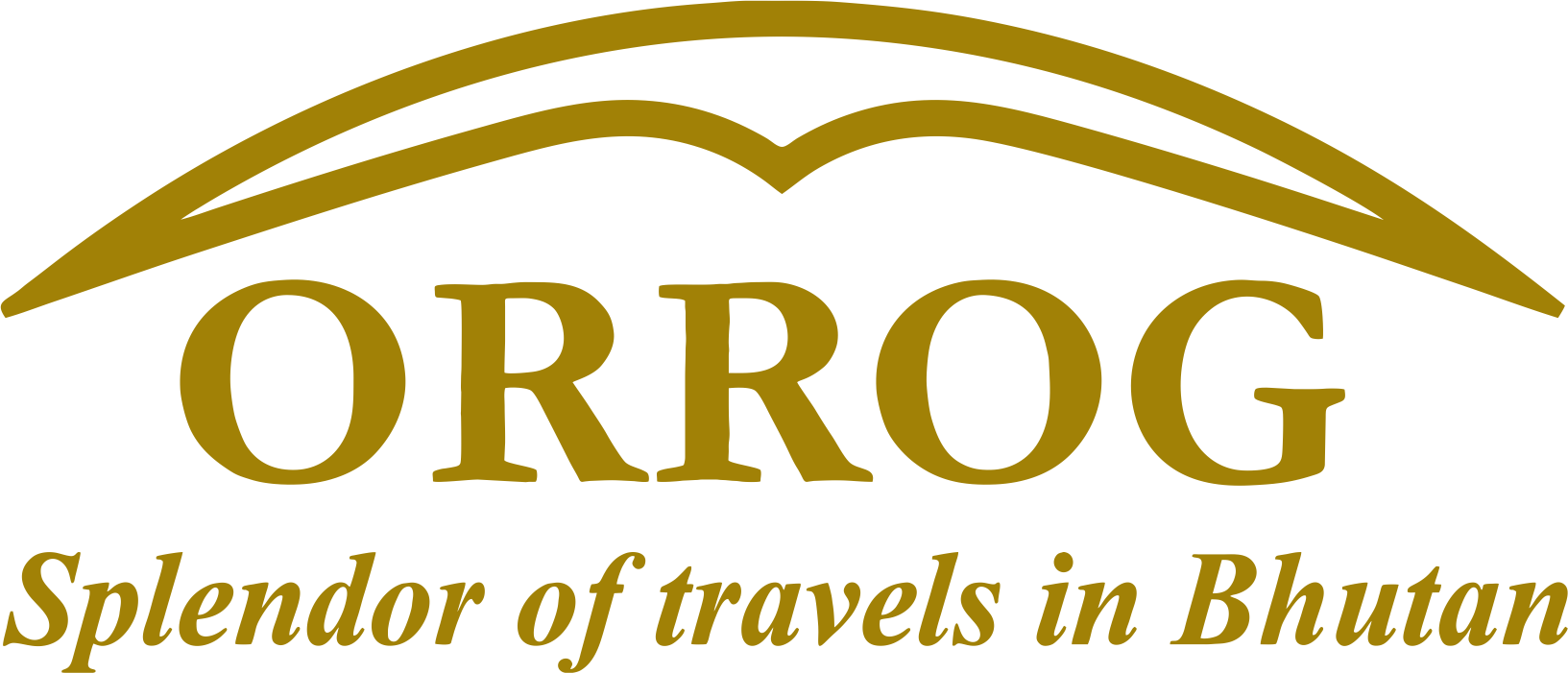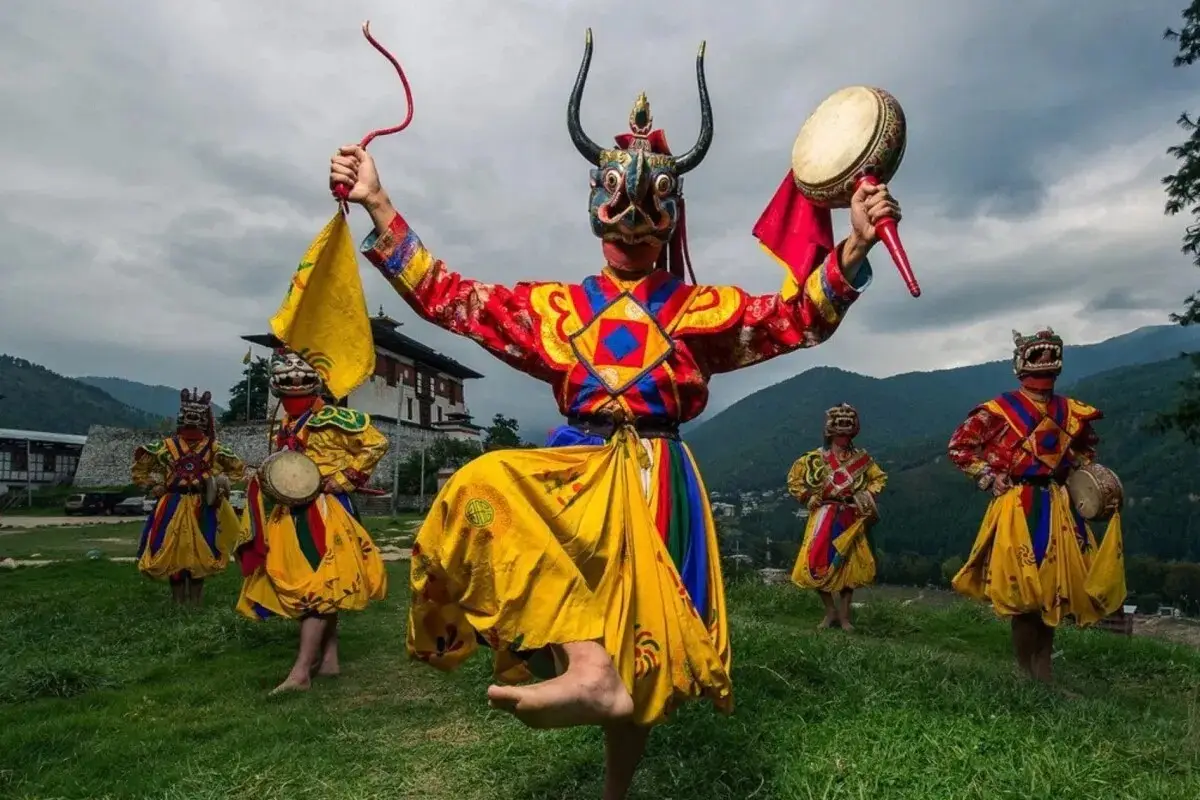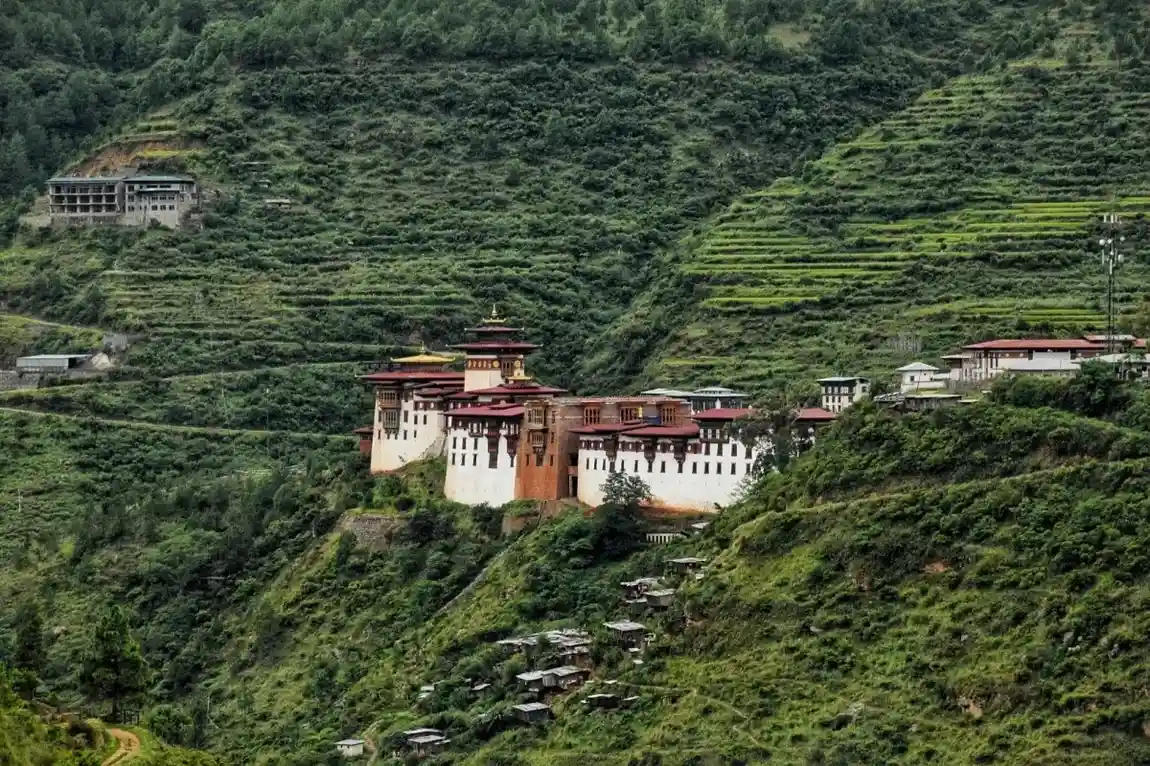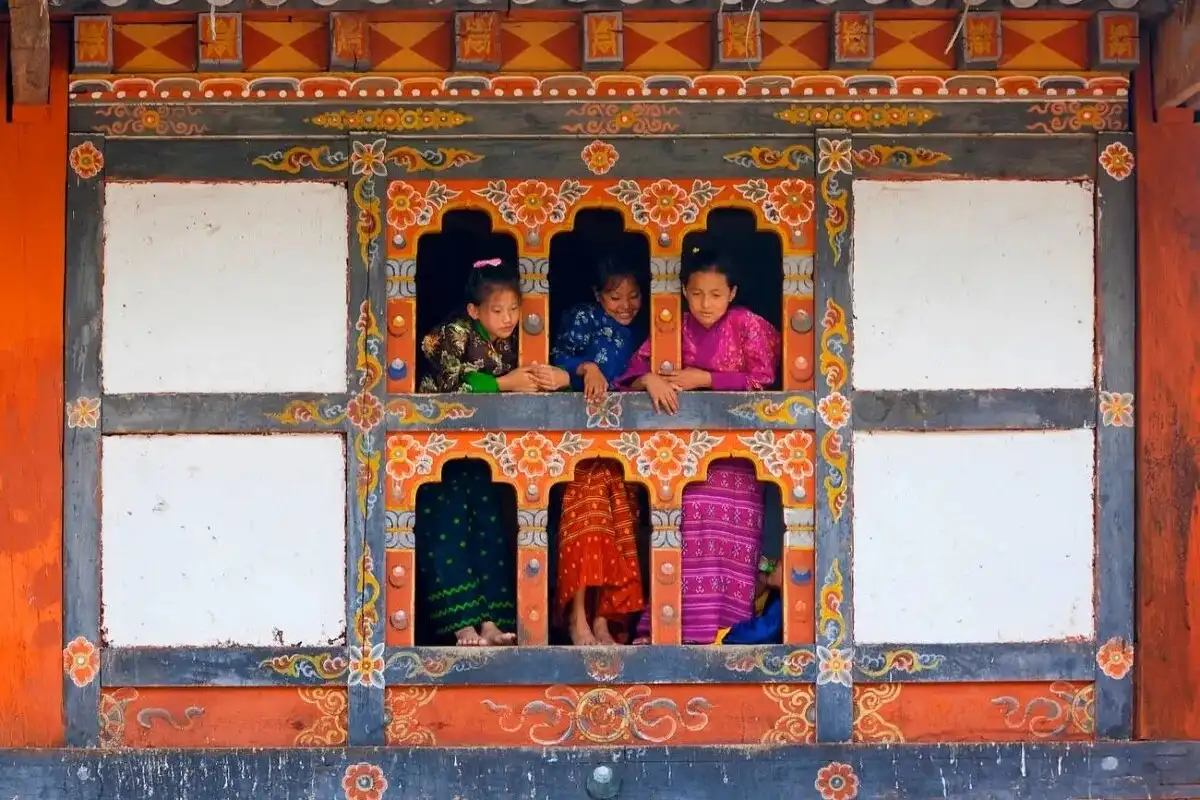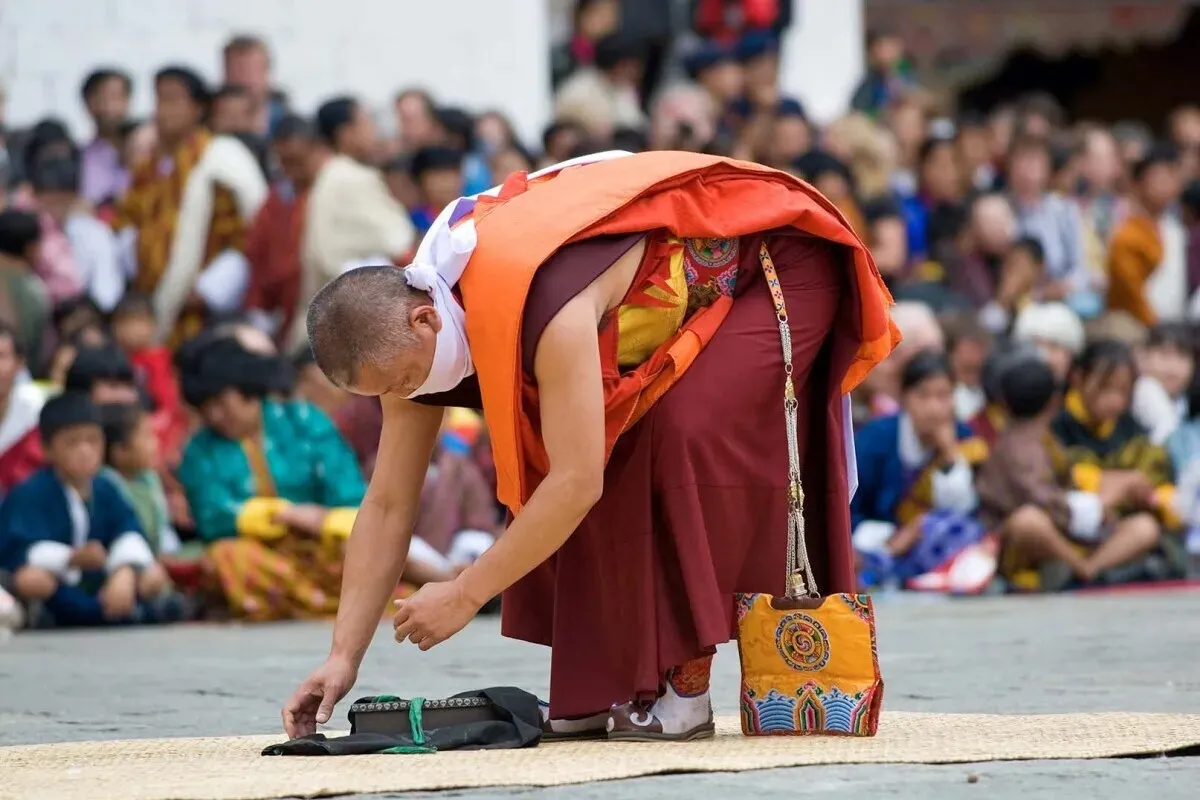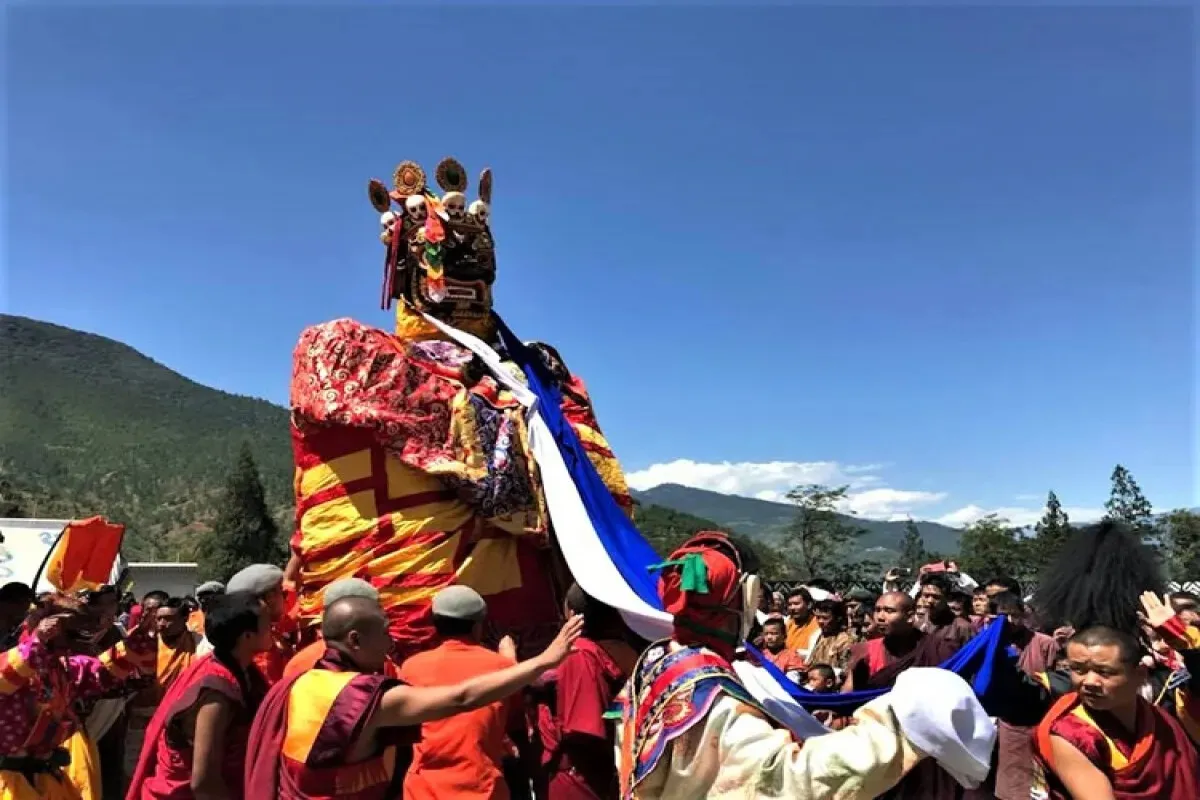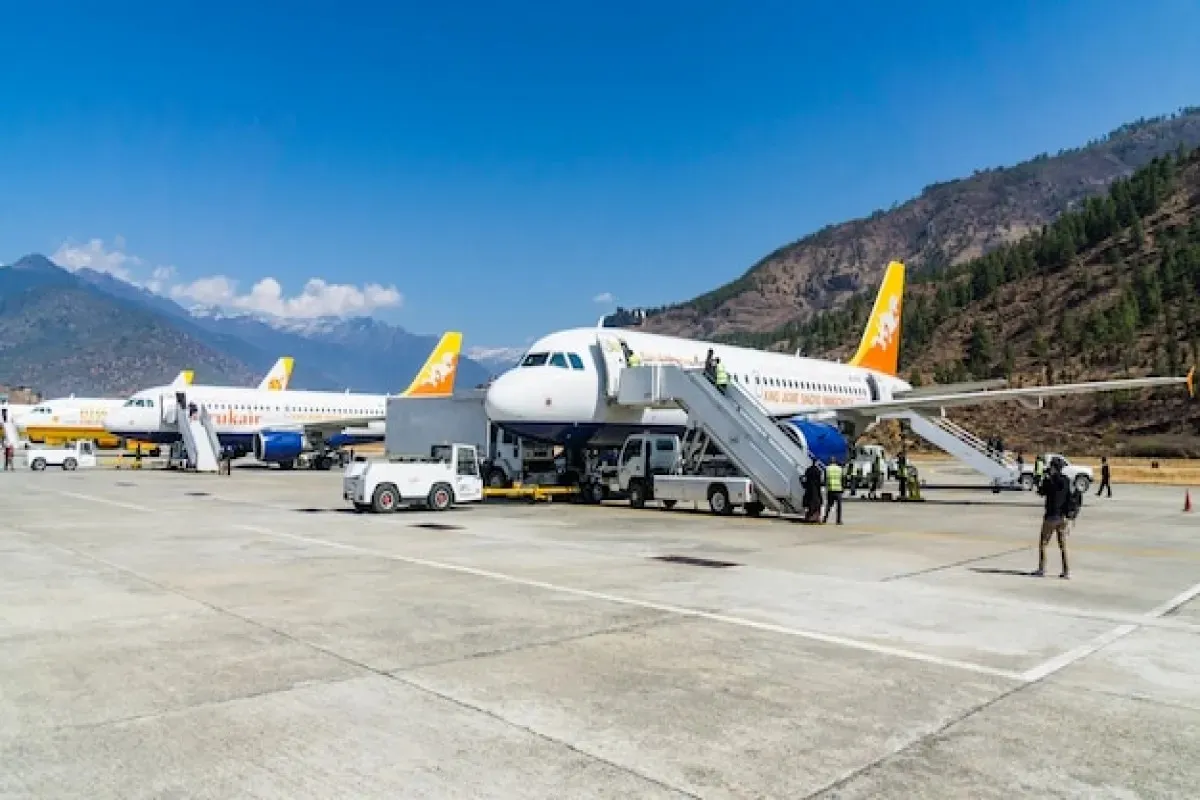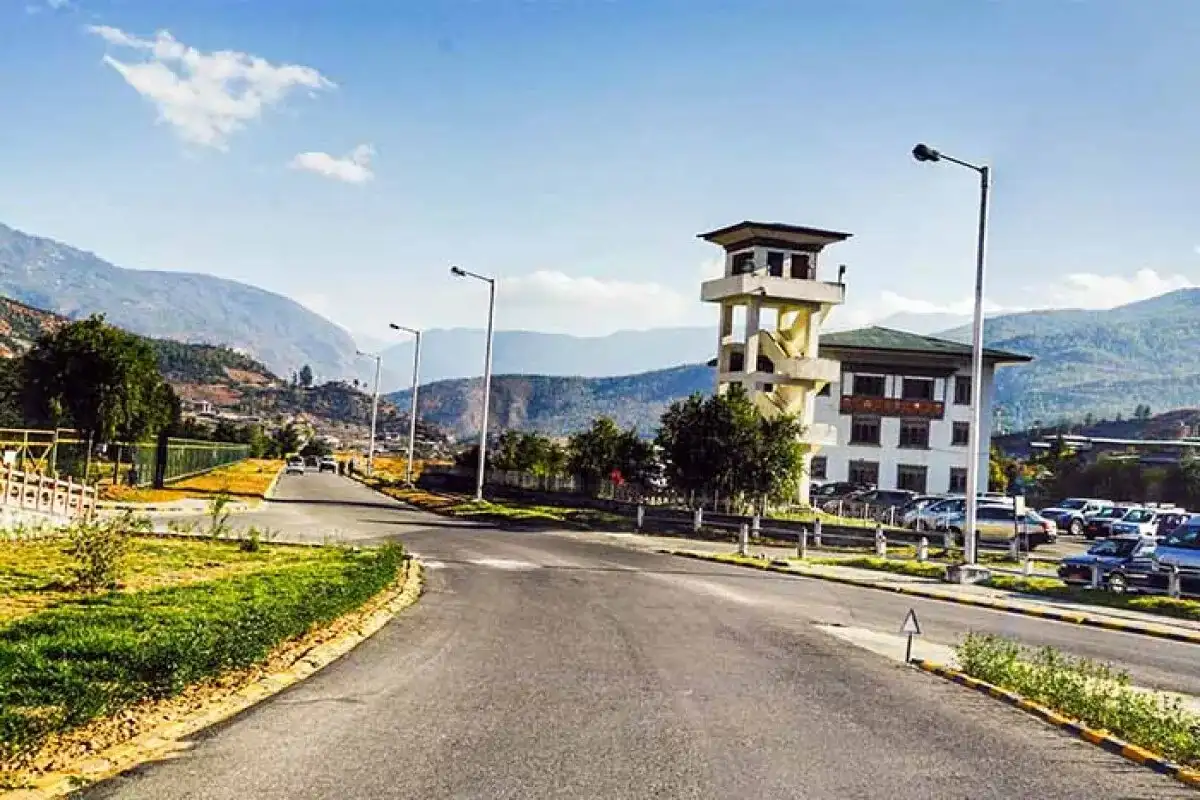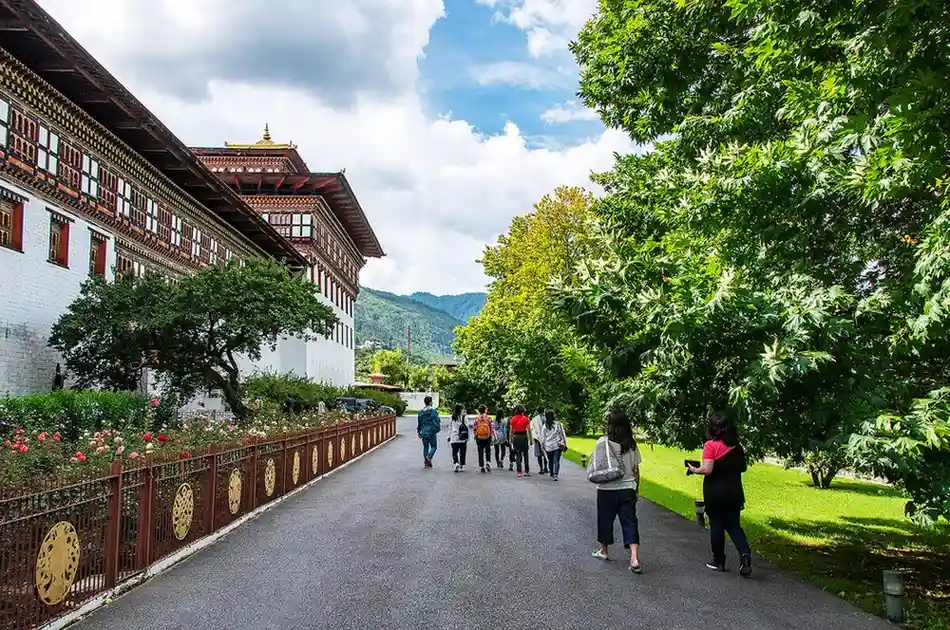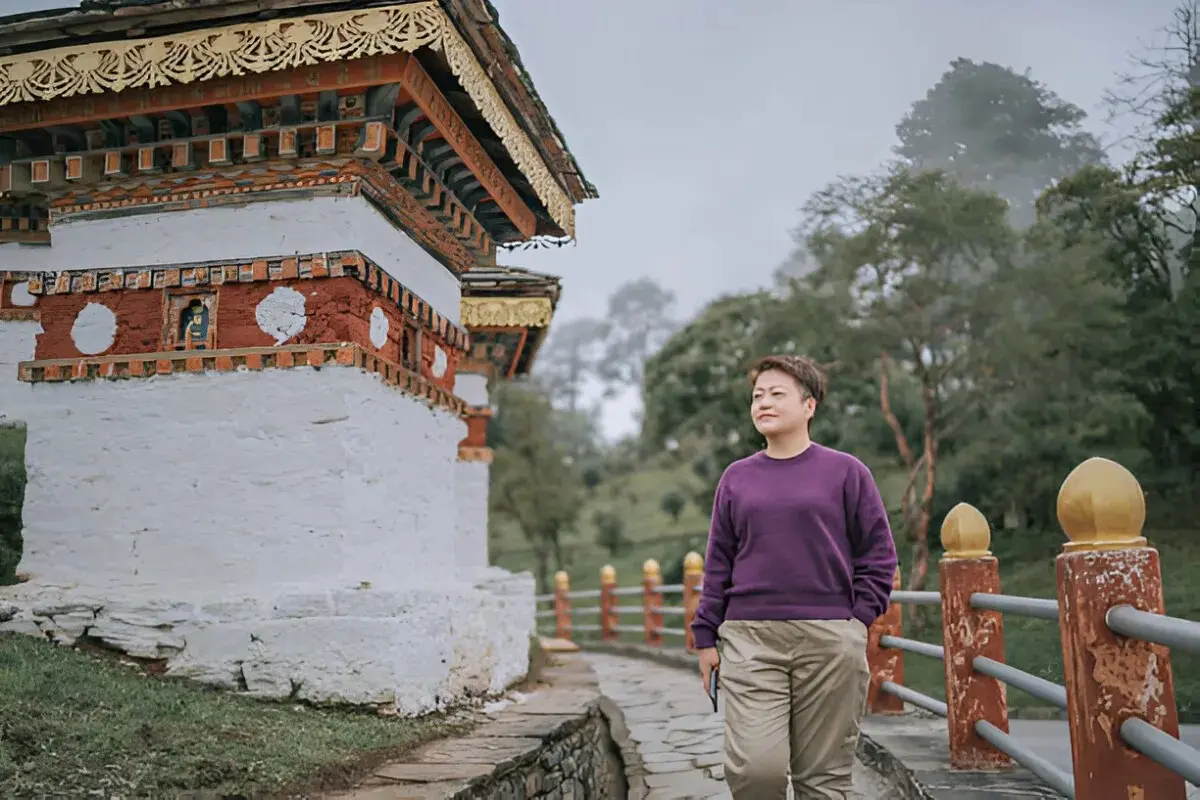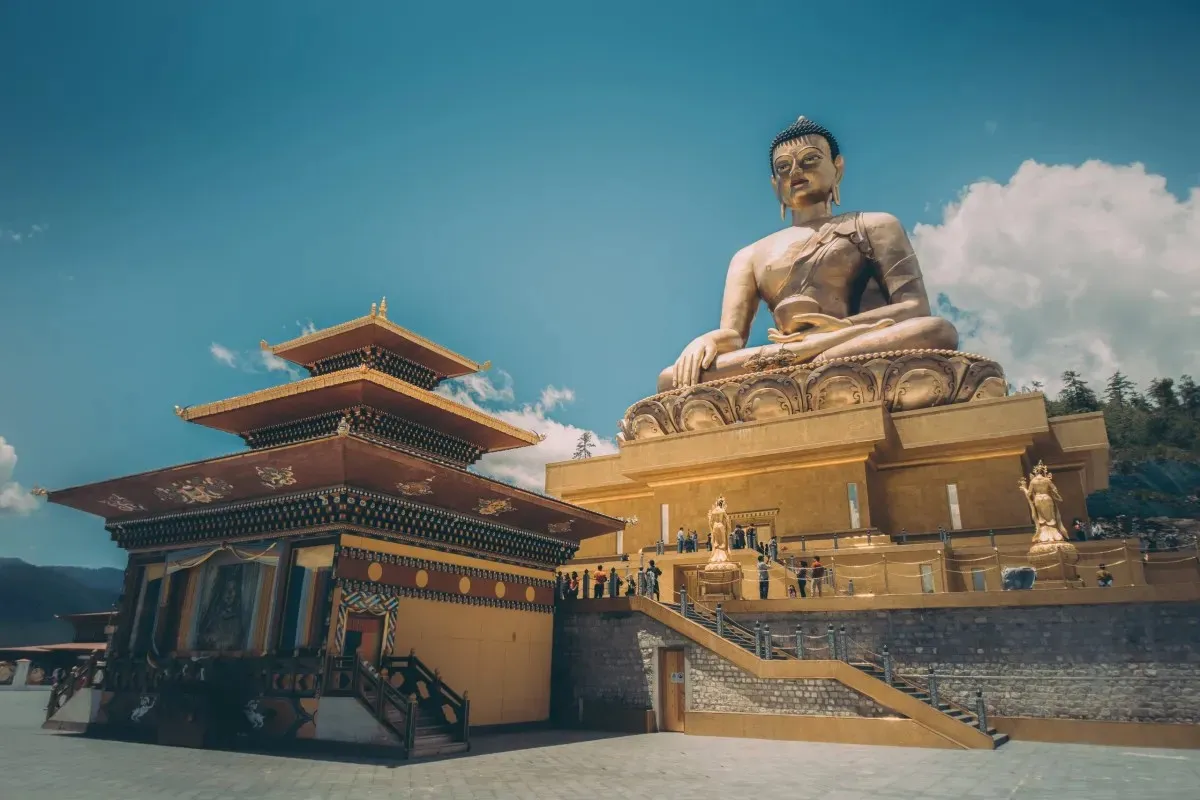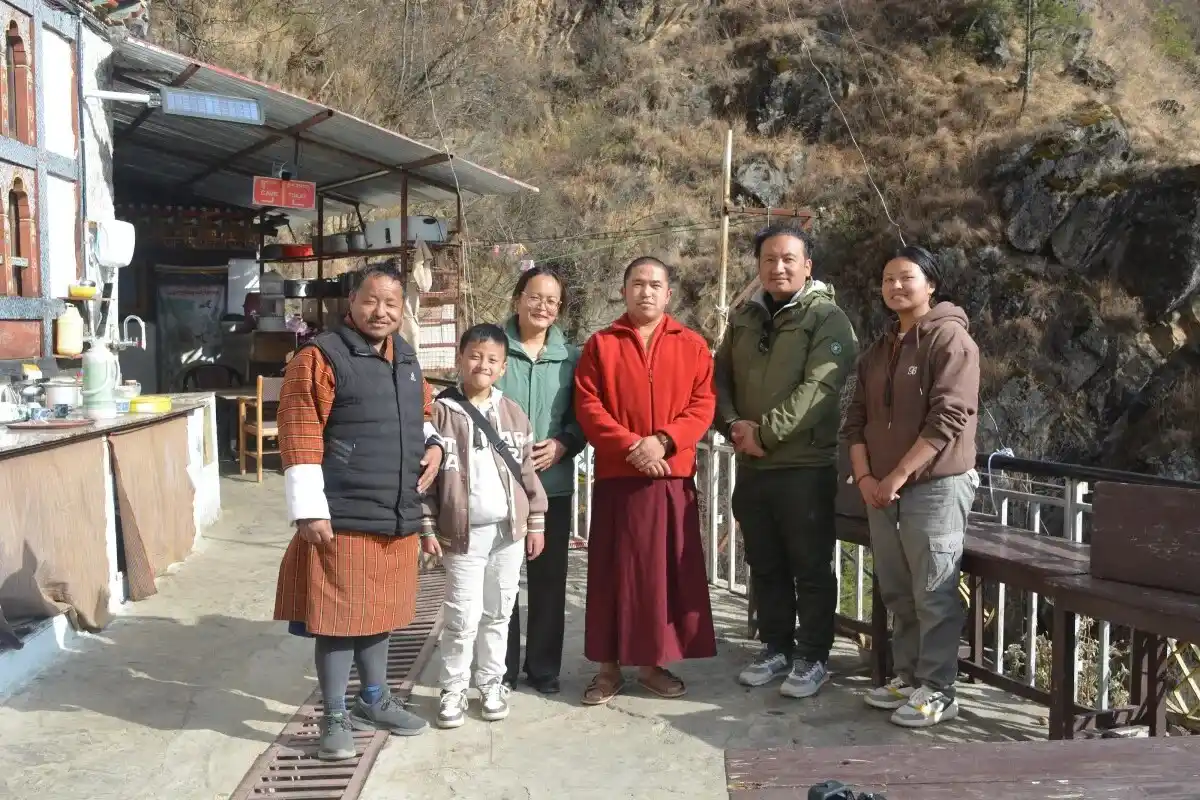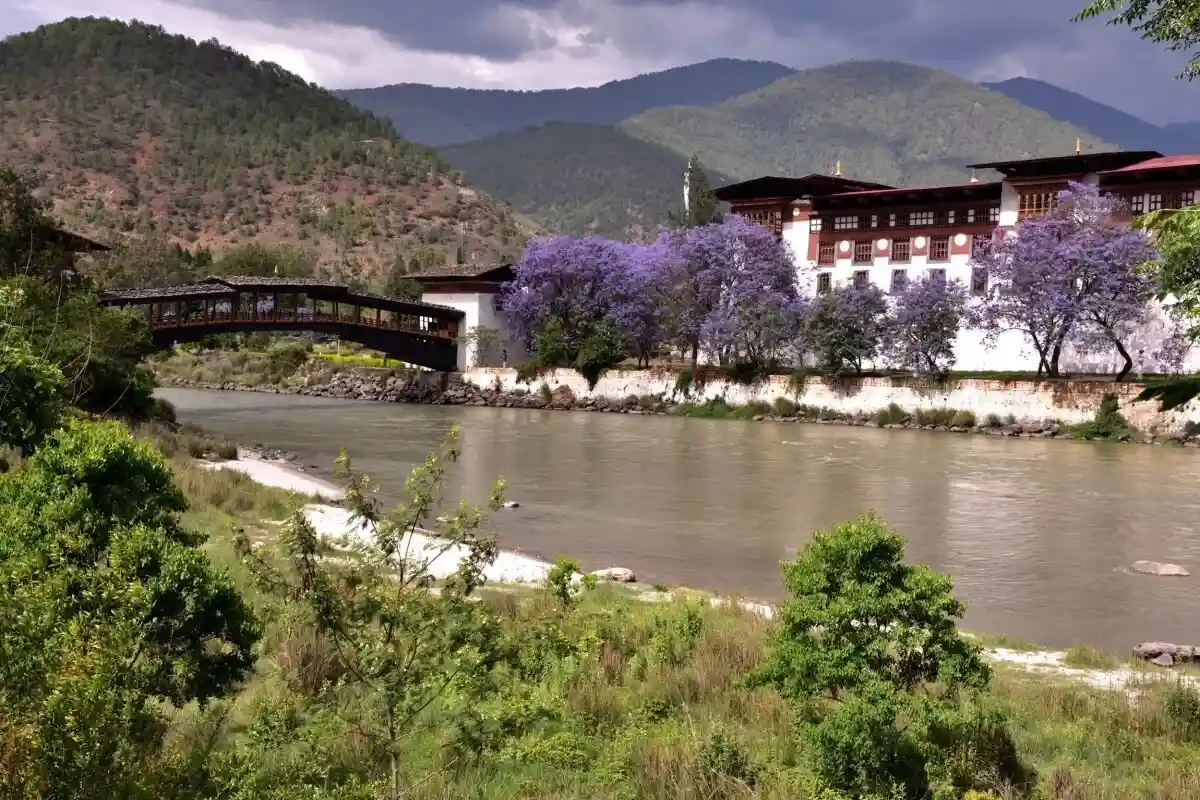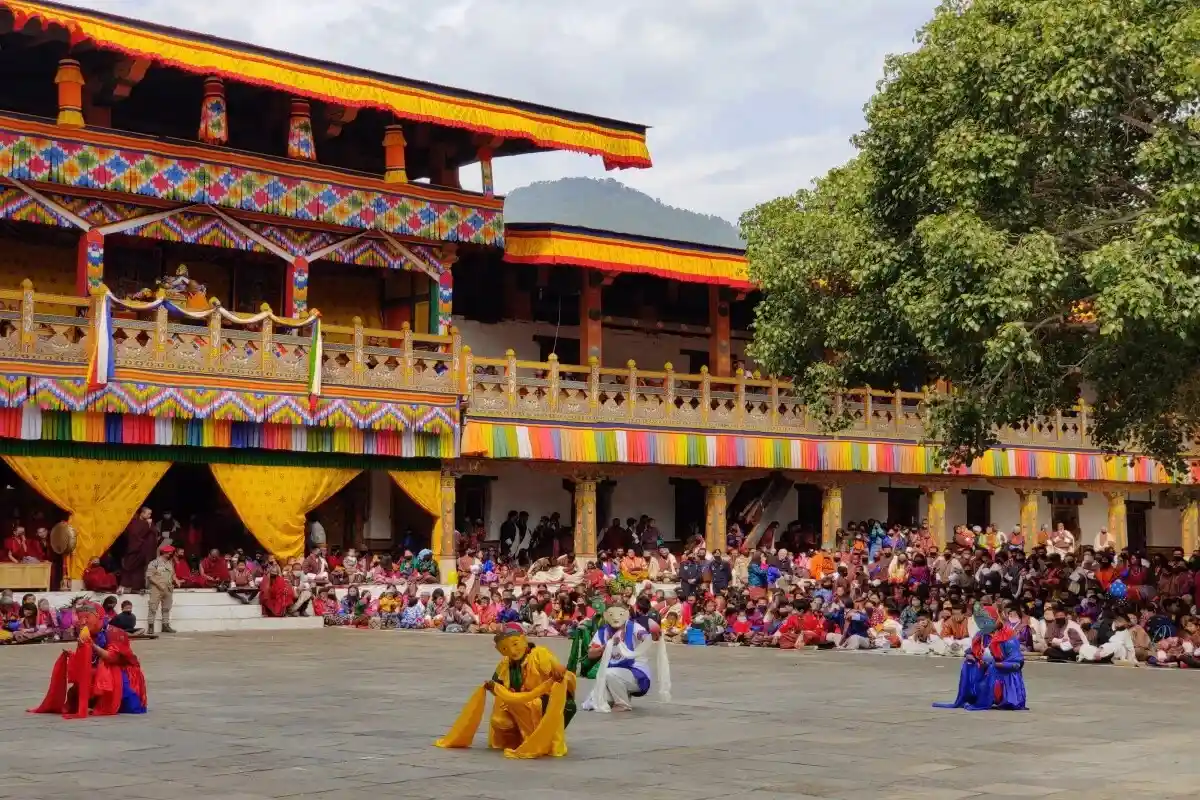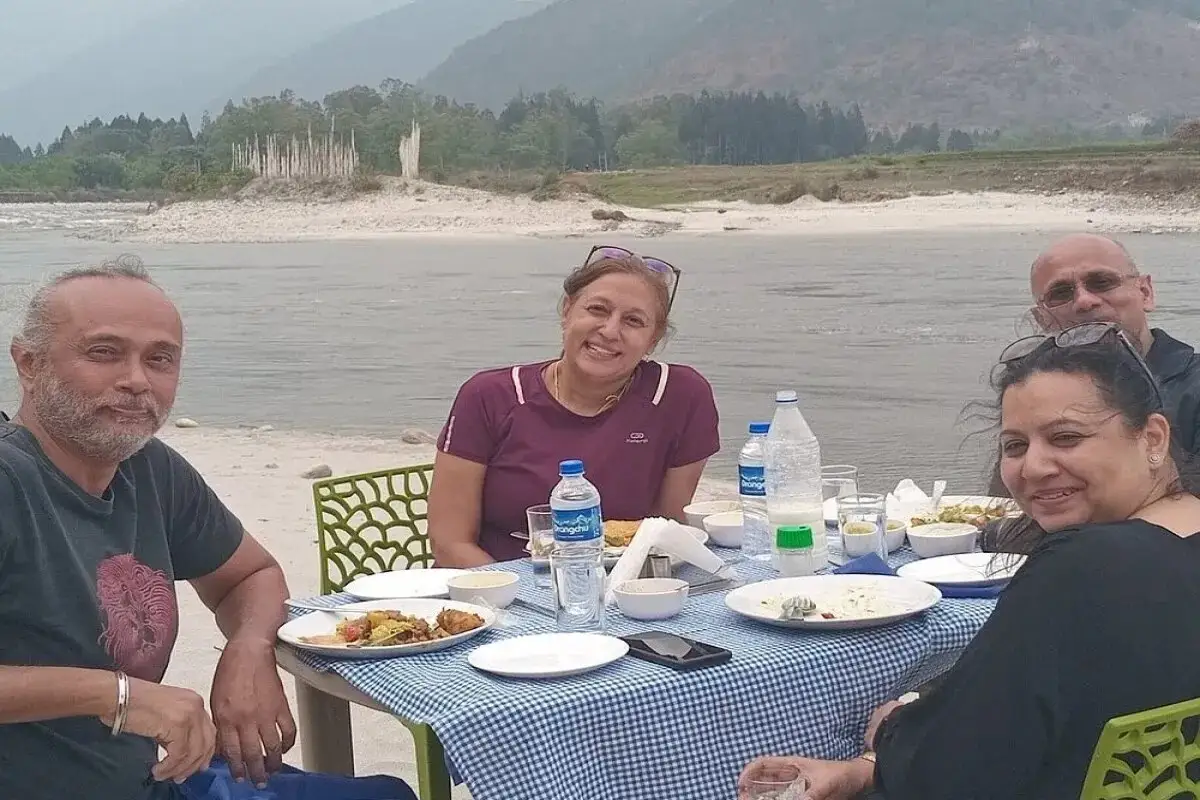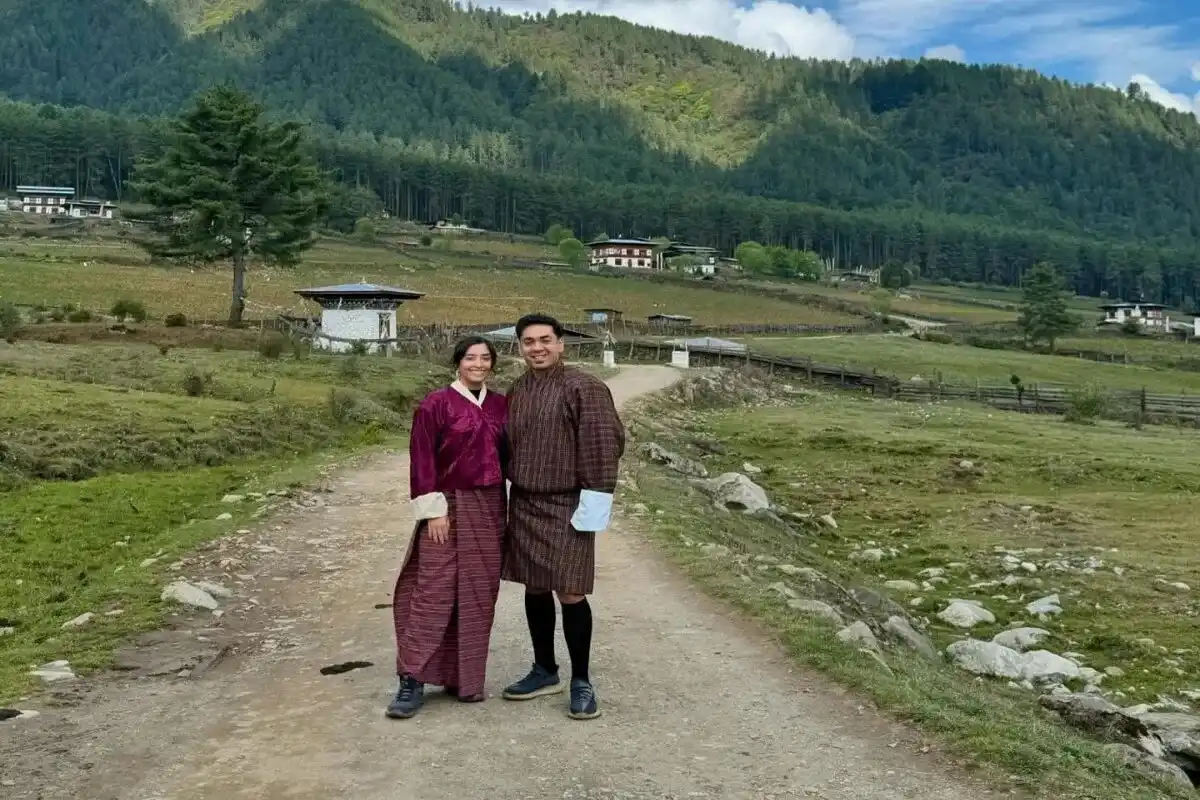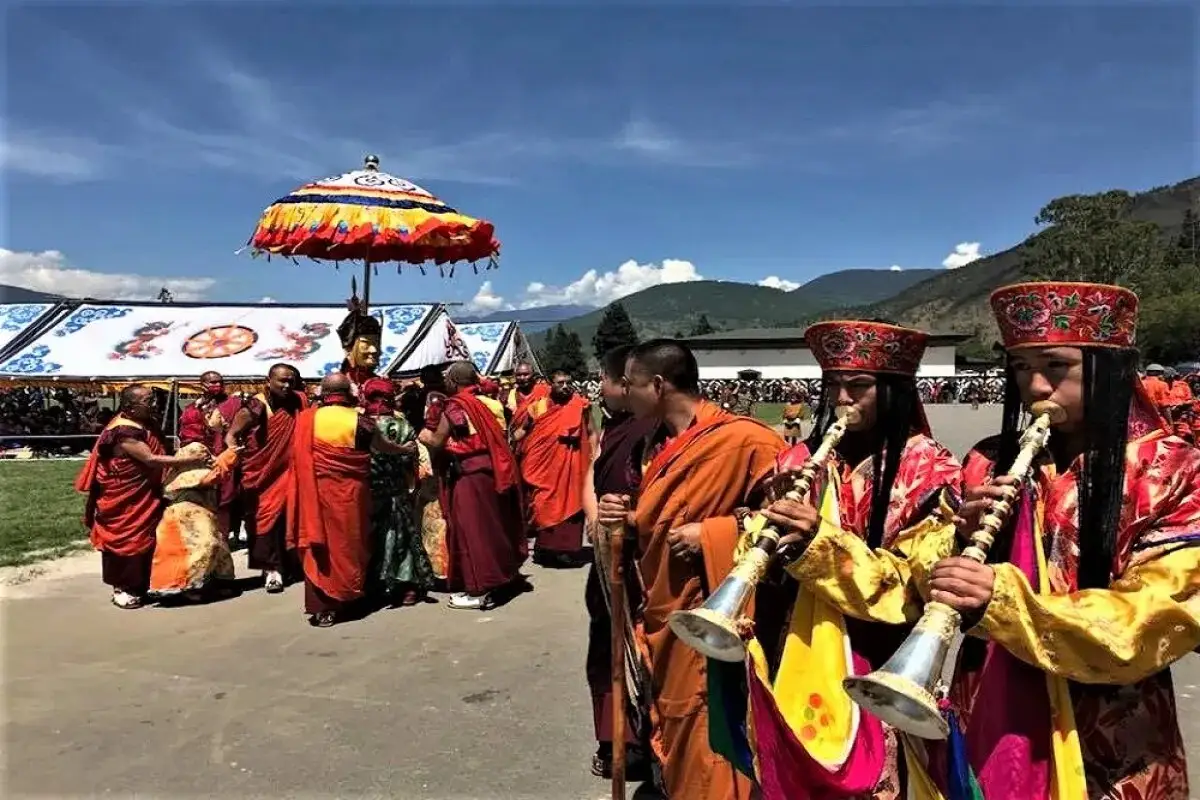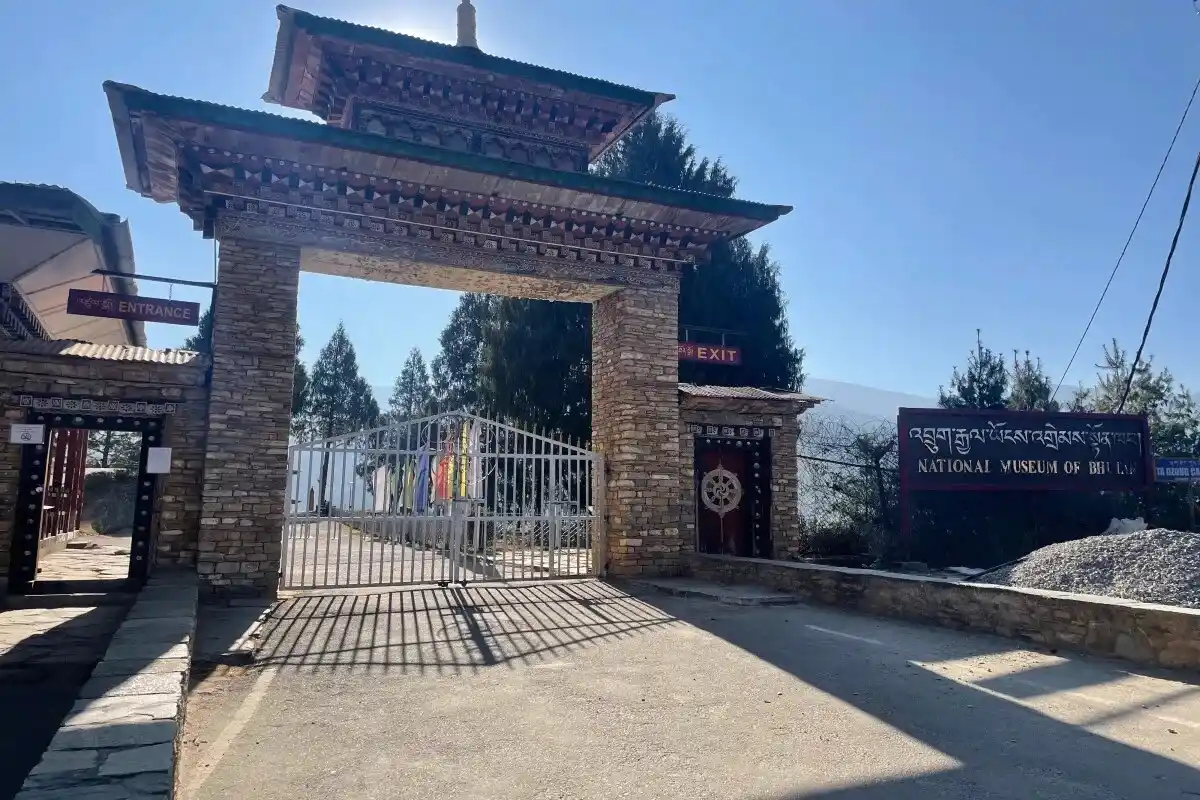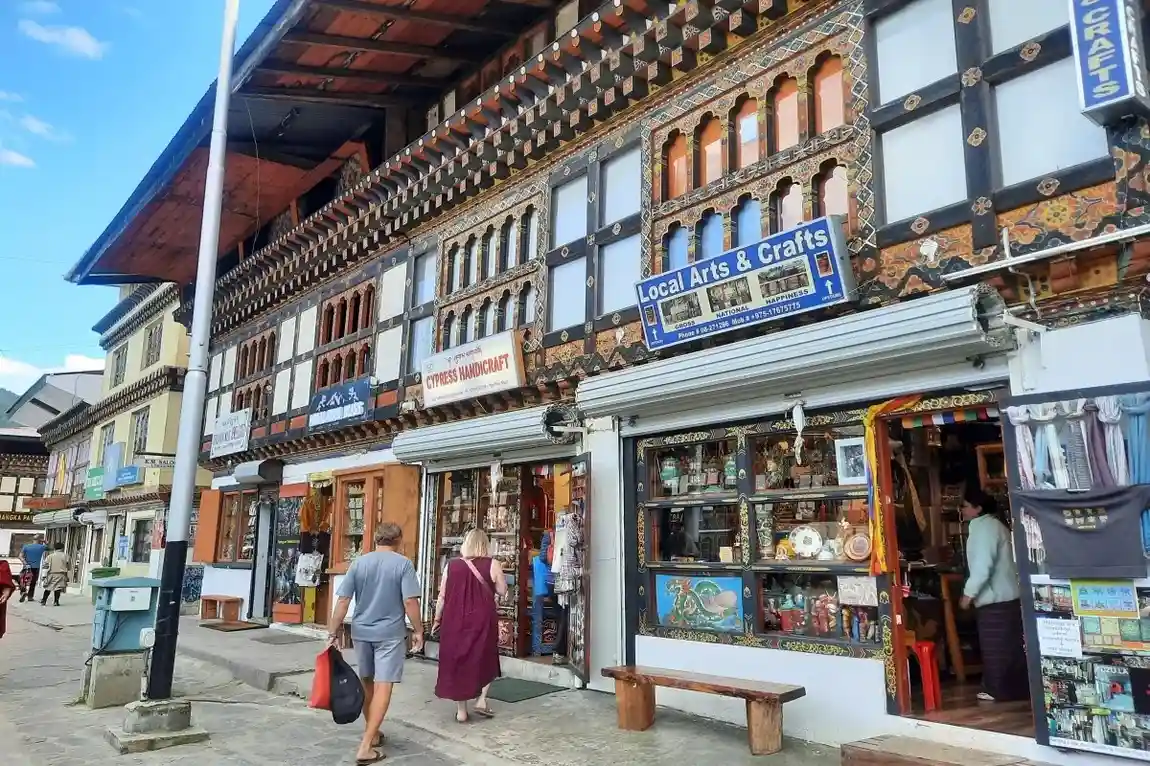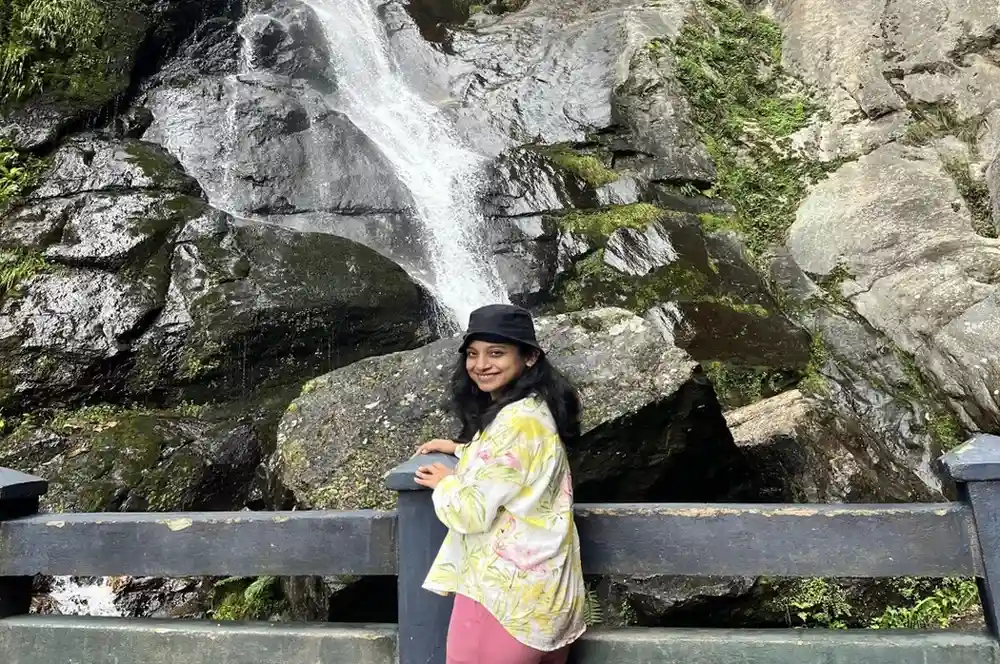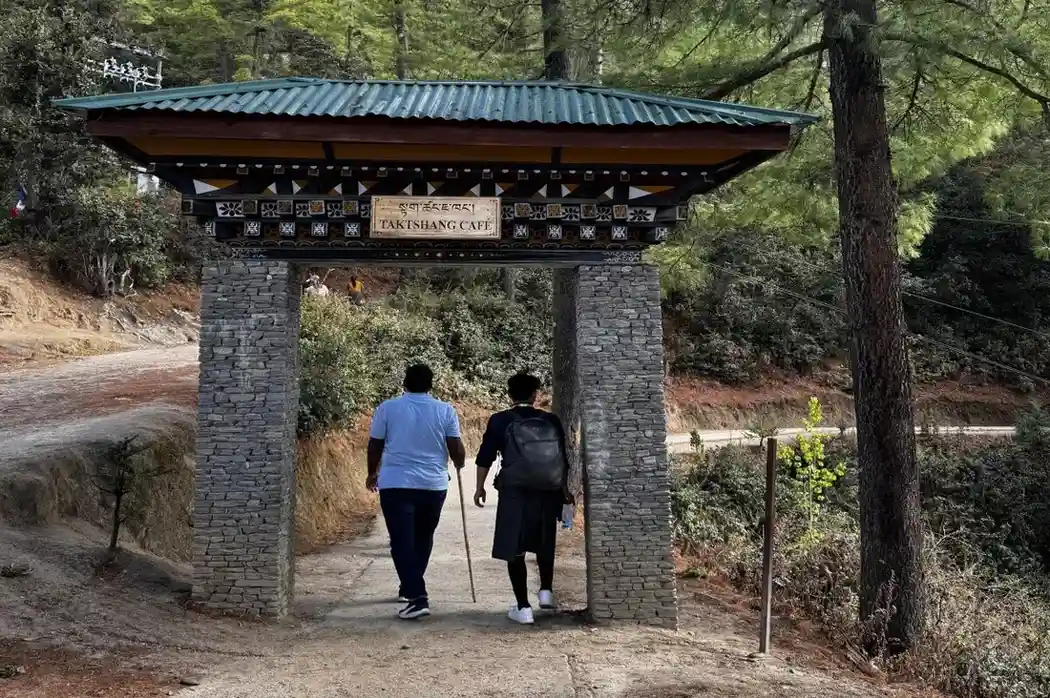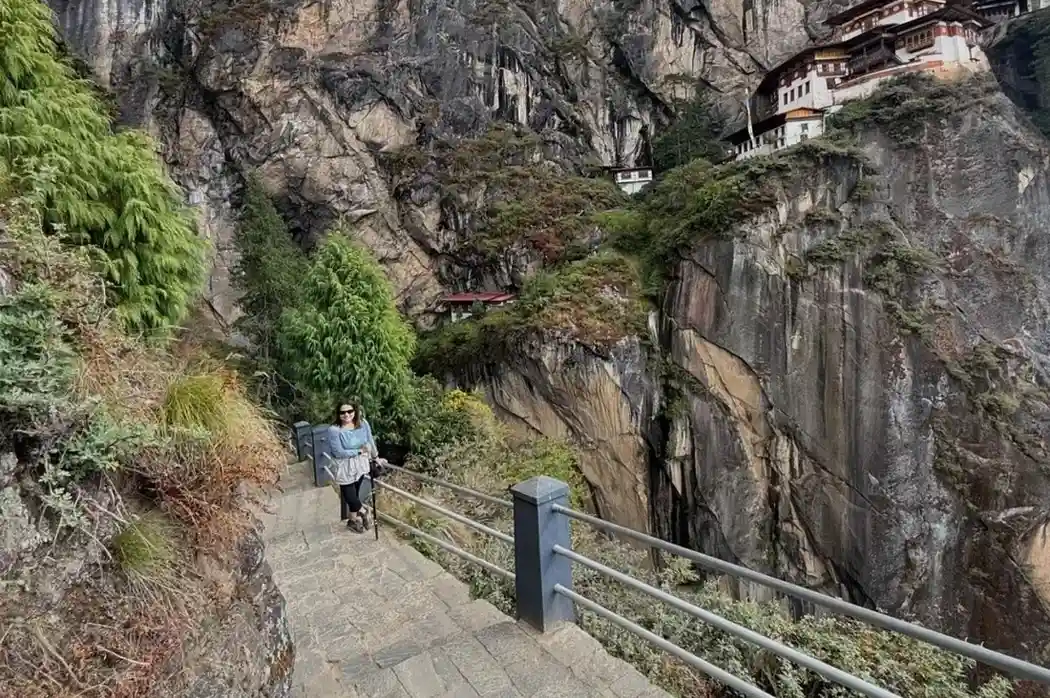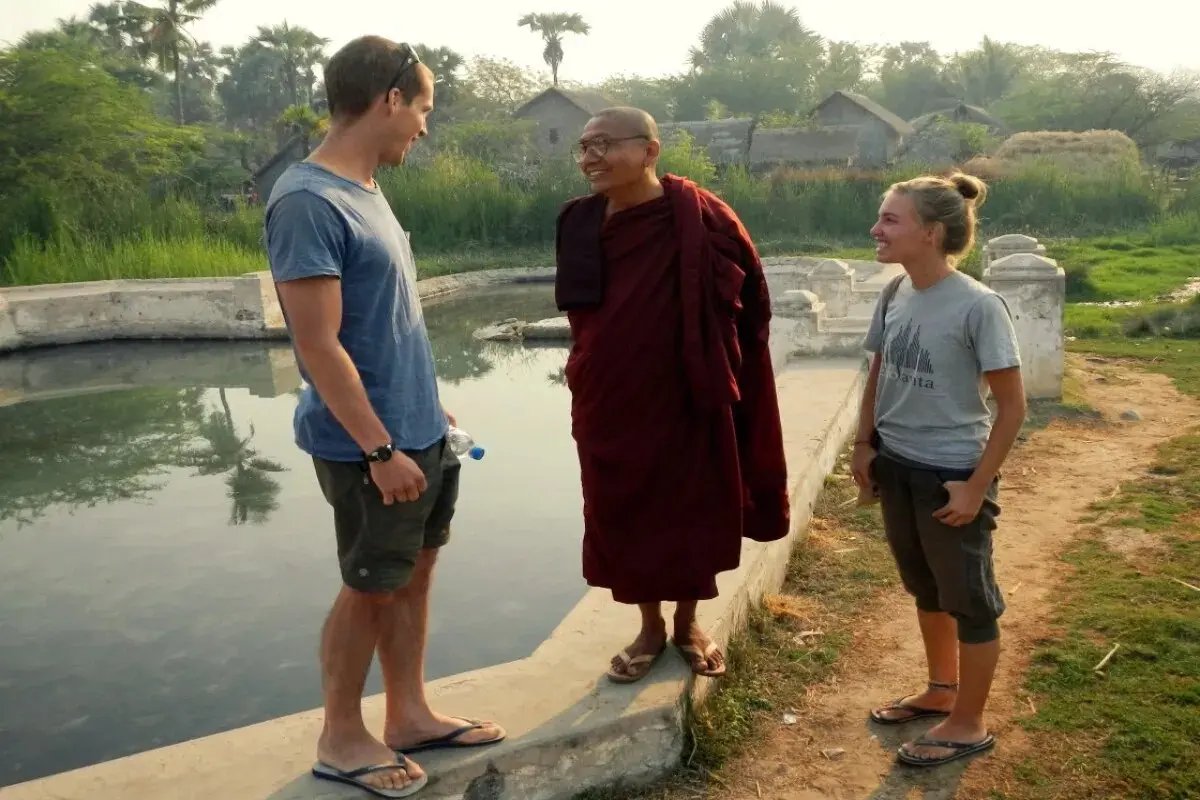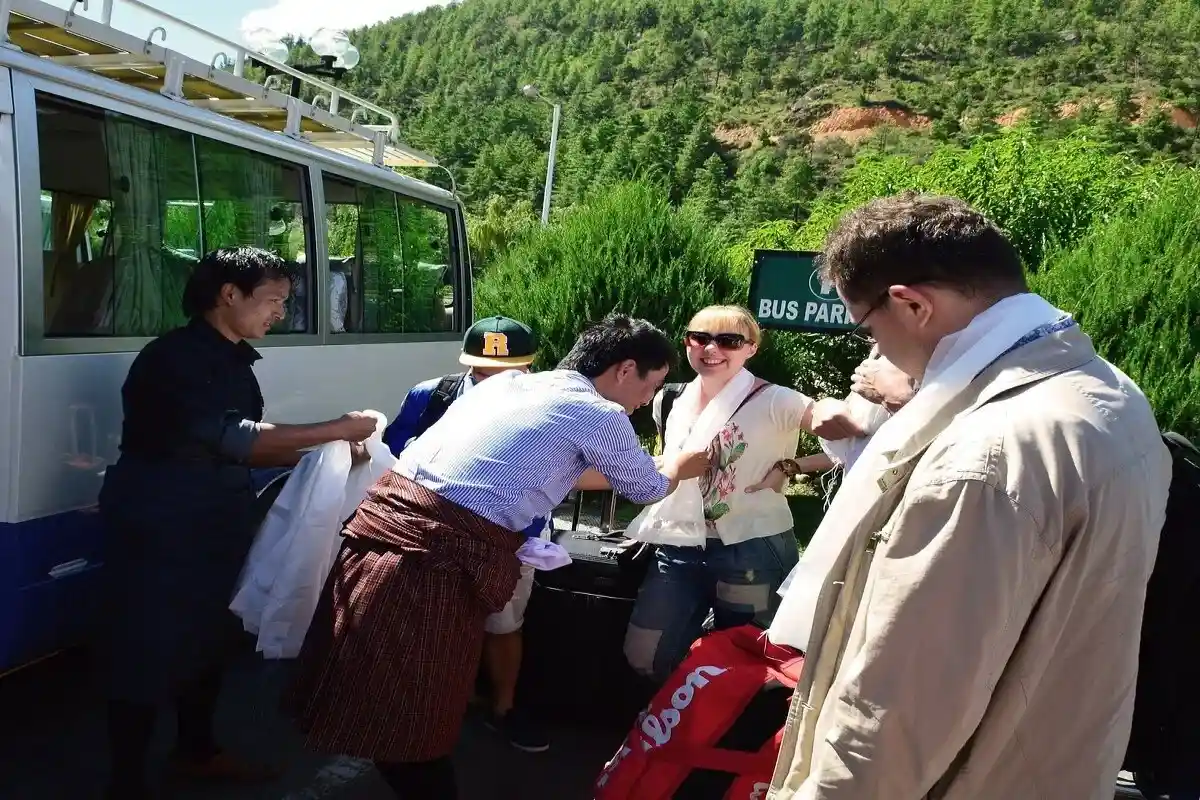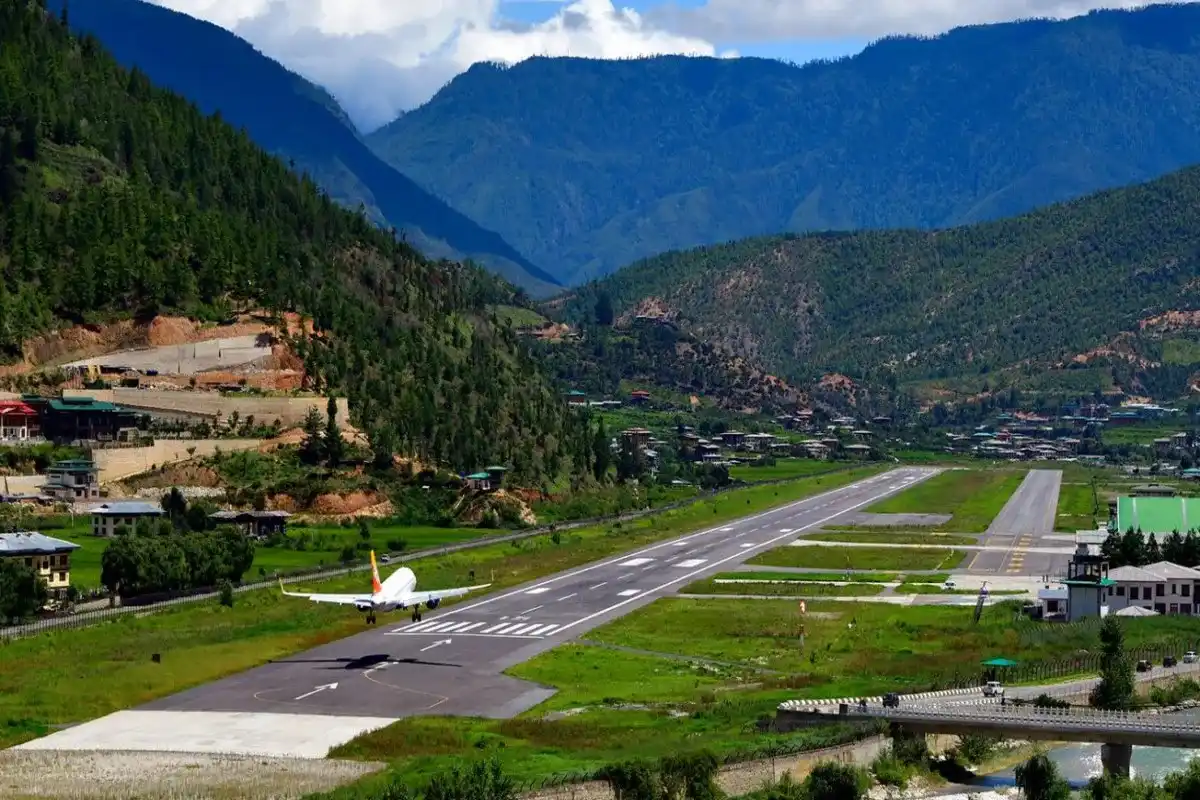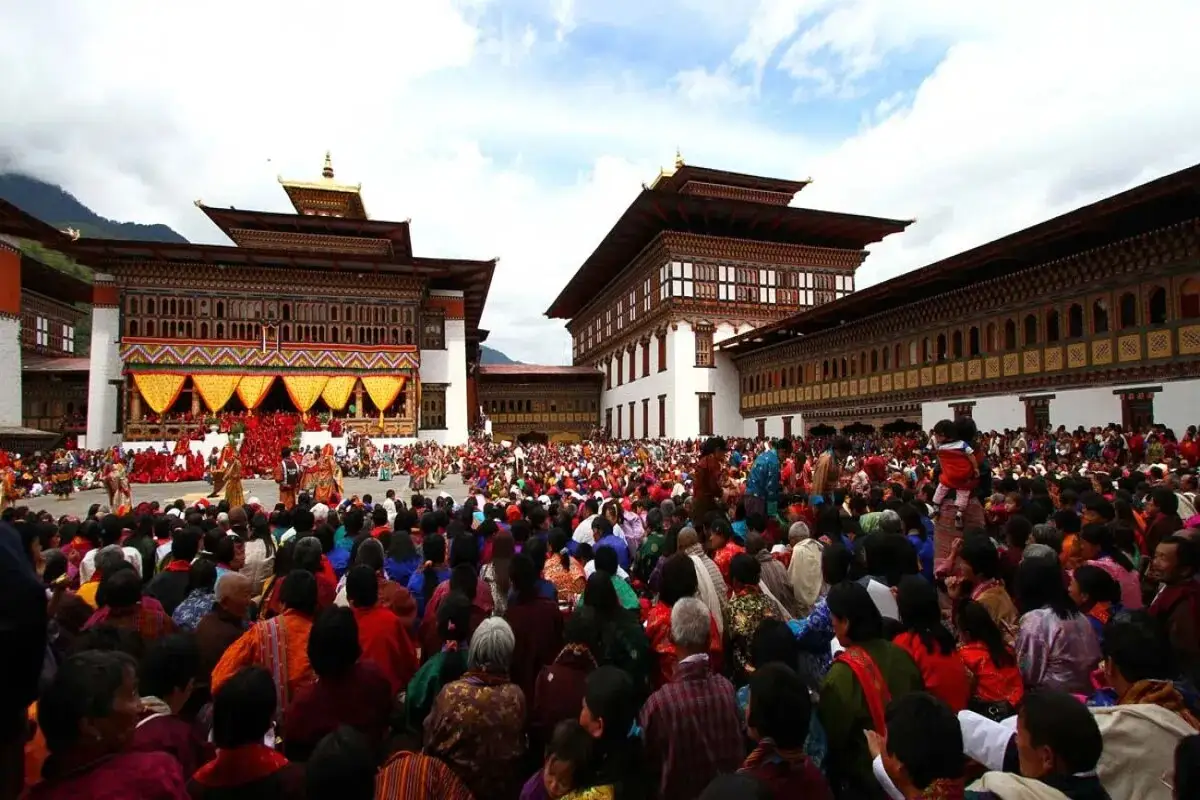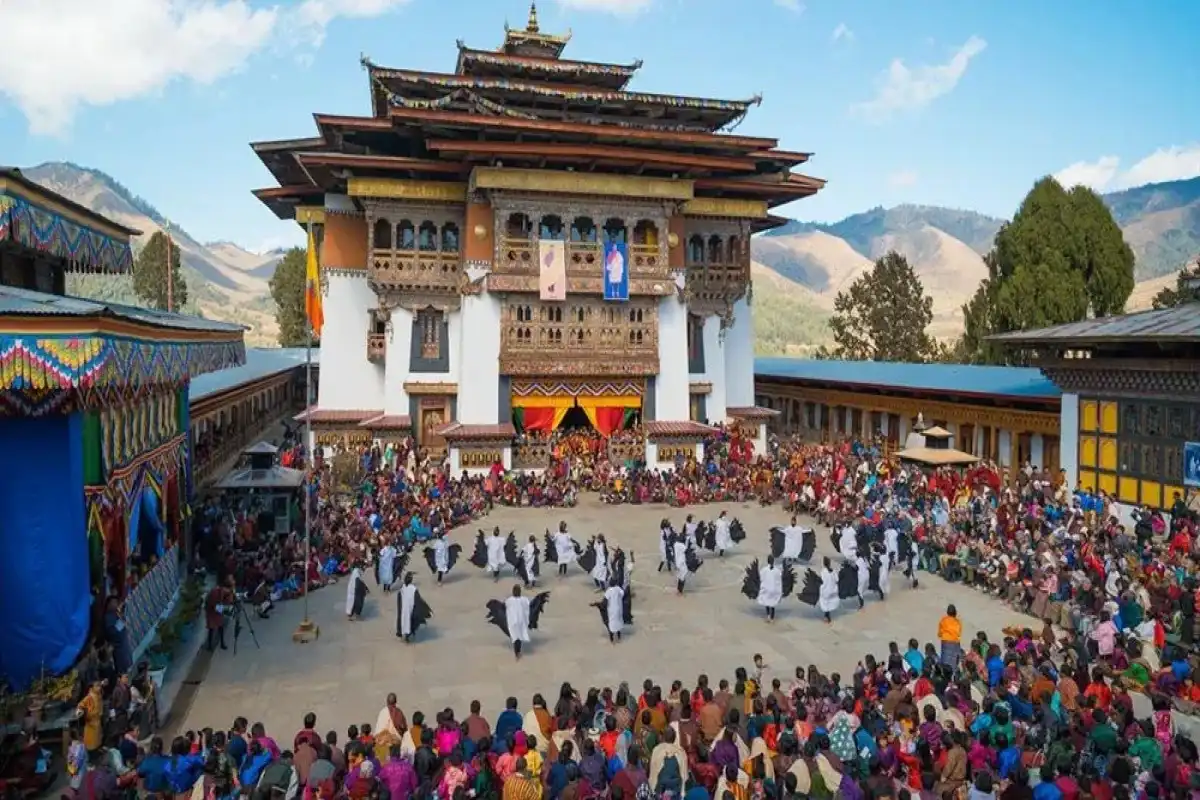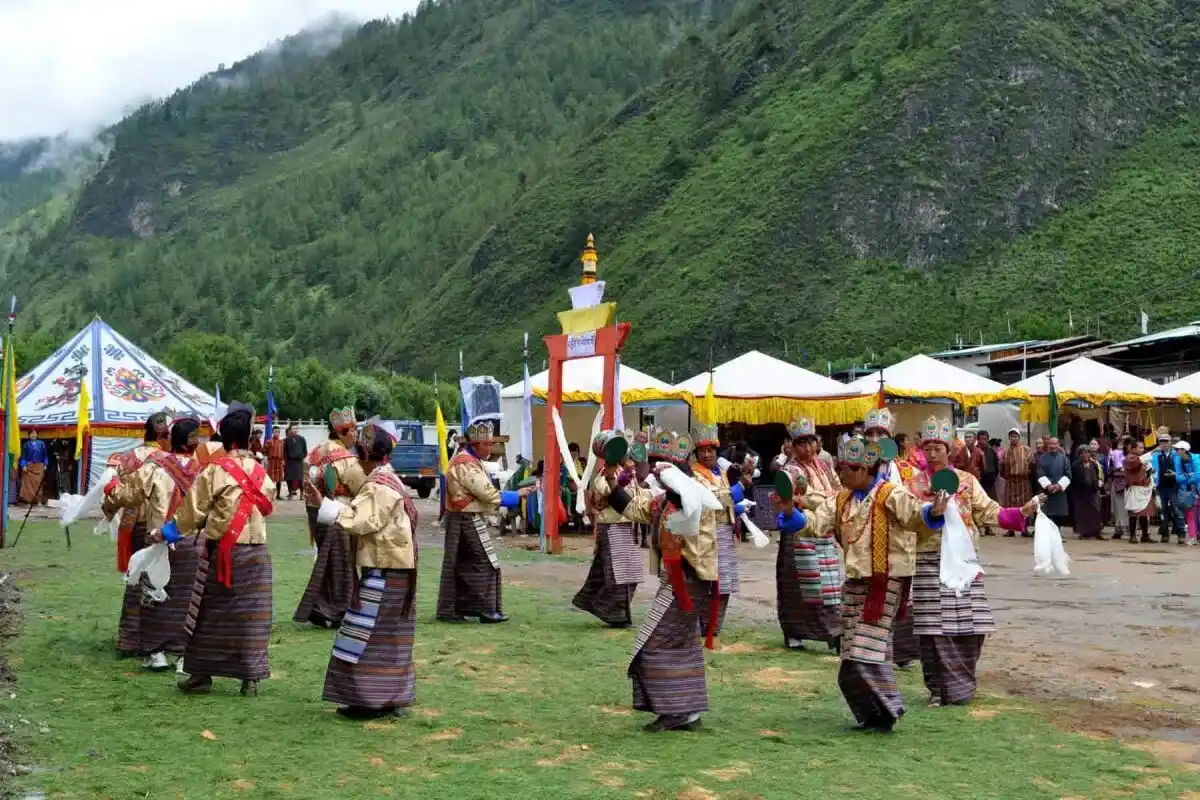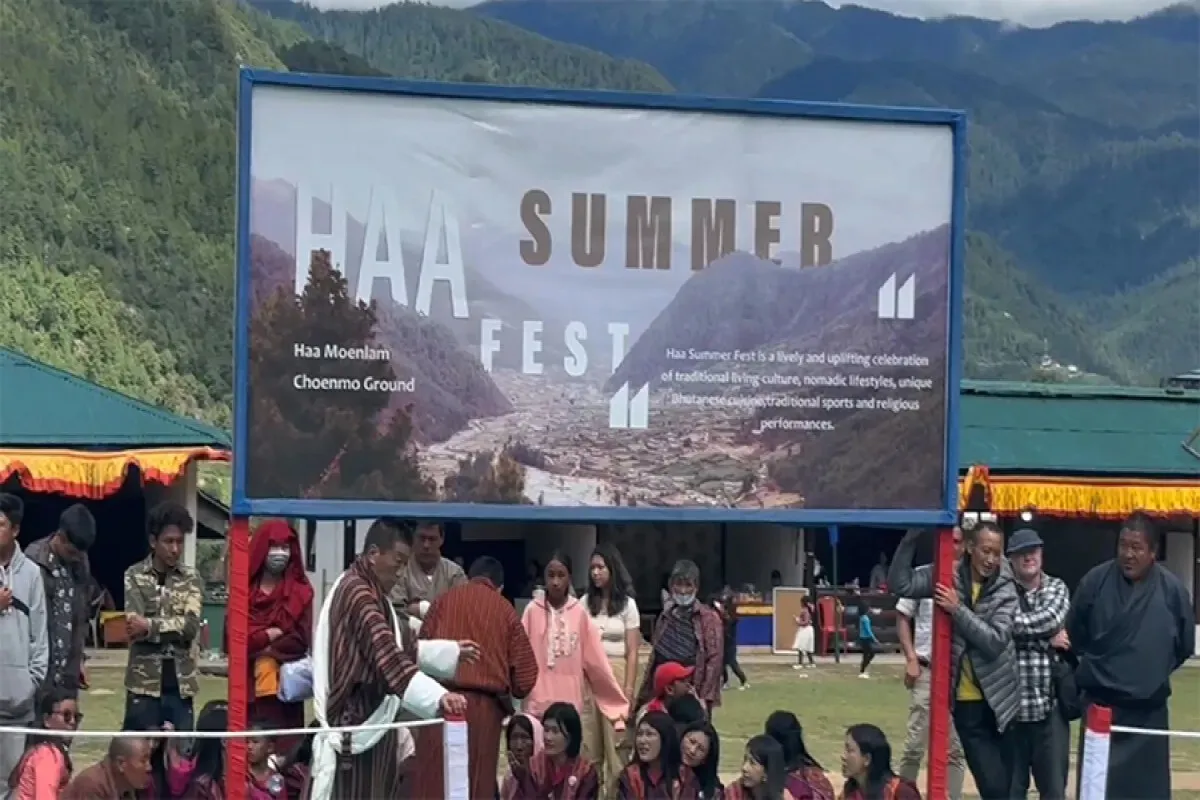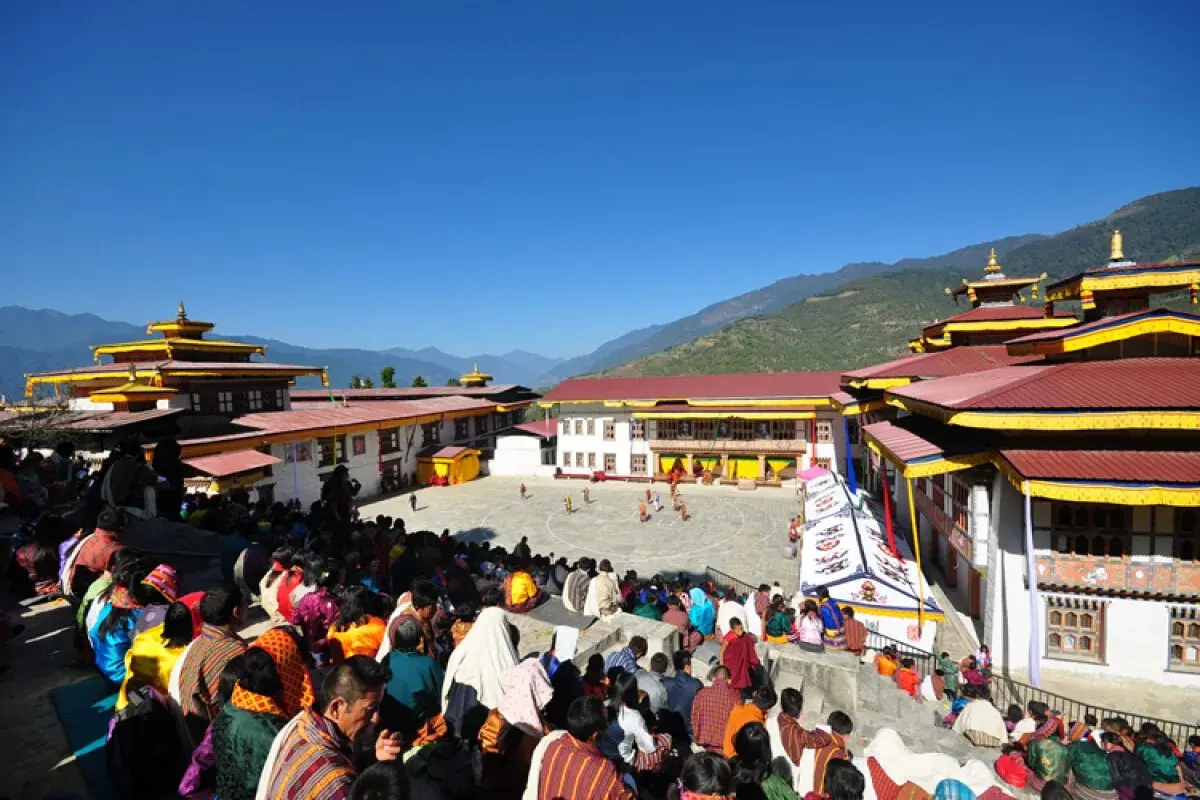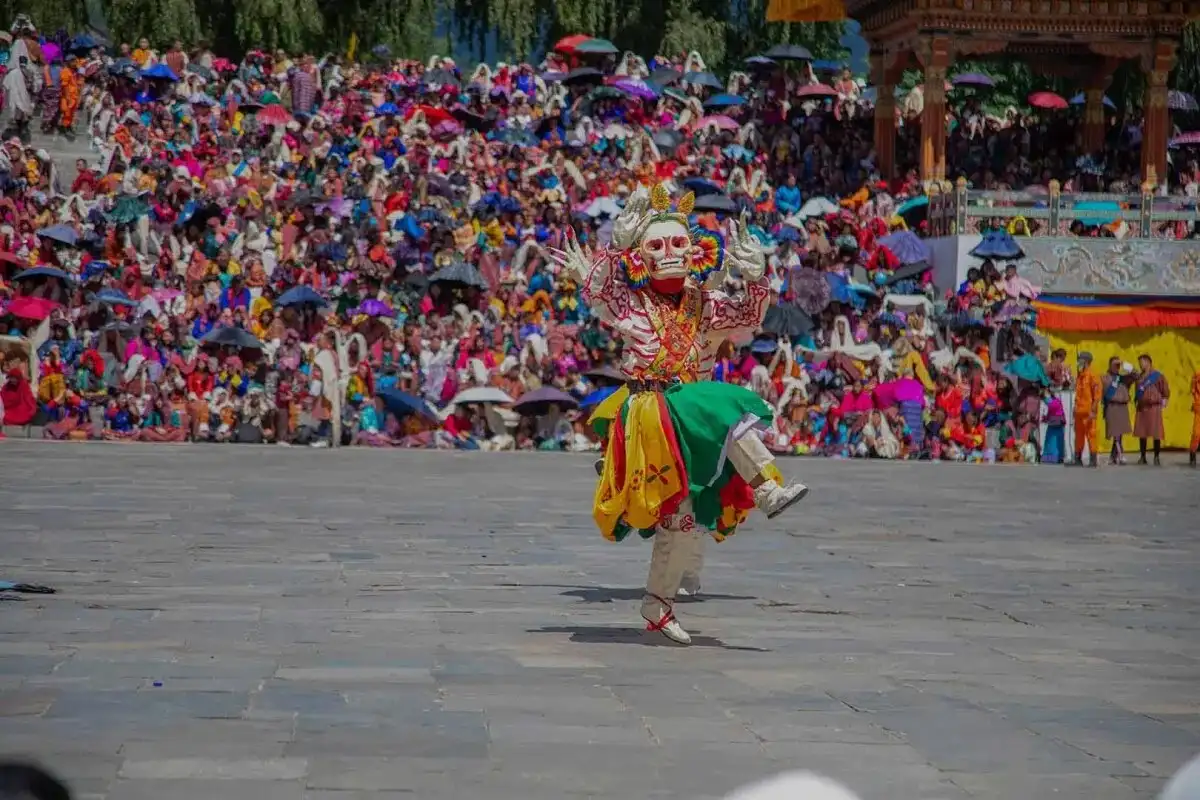Wangdue Phodrang Festival Tour - 8 Days
The Wangdue Phodrang Festival Tour is one of the most exciting ways to explore Bhutanese culture, religion, and beautiful landscapes. This adventure tour of 8 days is a mix of the valley beauties of Bhutan and the fascination of the religious monasteries and fortresses.
Highlights of the tour
- Witness the Masked Cham Dances and Ritual Performances at Historic Wangdue Dzong
- Explore Iconic Bhutanese Monasteries and Dzongs
- Travel Through Dochula Pass with Panoramic Views of the Himalayas
- Immerse in Prayer Flag Ceremonies, Butter Lamp Lighting
- Hike to Bhutan’s Iconic Tiger’s Nest Monastery
- Relax with Traditional Hot Stone Baths and Herbal Therapies
Trip Overview
The highlight of the trip is the Wangdue Phodrang Festival. It brings together monks and locals. They perform sacred cham dances, wear colorful masks. Then also celebrate their rich Buddhist traditions or spiritual traditions. In this festival, tourists will also visit some of the popular monuments like Tiger Nest Monastery, Punakha Dzong, Tashichho Dzong, and National Memorial Chorten. Visiting the Dochula Pass, the admirers would see breathtaking characteristics of the Himalayas. This cultural trip lets you see Bhutan's rich traditions. You’ll love the warm hospitality of the people. You can experience their religious rites and enjoy stunning natural landscapes.
Highlights of the Tour
You will get to experience different traditional mask dances , explore iconic monastries and Dzongs, travel Dochula Pass . You can try relaxing hot stone bath and different meditation practices.
Witness the Masked Cham Dances and Ritual Performances at Historic Wangdue Dzong
You will get to participate in the cham dances of masked monks in bright colors. They believe that these religious ceremonies make people blessed and prevent evil. It is something special to observe the festival in the territory of Wangdue Dzong. This is because this fortress has been a place of Bhutanese spirituality for centuries.
Explore Iconic Bhutanese Monasteries and Dzongs
You will visit some significant dzongs and monasteries on the way to the tour. To begin with, you will be able to see the historic Tashichho Dzong in Thimphu. Second, you will visit Punakha Dzong. It is the Palace of Great Happiness, where all people talk about history and the Bhutanese culture of Buddhism. The architecture of the buildings there is peculiar. You can see the religious symbolism in the architecture.
Travel Through Dochula Pass with Panoramic Views of the Himalayas
One of the most scenic and the most exciting sections of the journey is the drive through Dochula pass. You can enjoy the view of snow-covered Himalaya peaks particularly on a clear day and explore The 108 chortens of the pass, and they make it not only a point of sightseeing but a spiritual one too.
Immerse in Prayer Flag Ceremonies, Butter Lamp Lighting, etc.
You can enjoy flag hoisting or lamp lighting at the monasteries. It is thought that these acts radiate positive energy and serenity and thus, solitary and personalize your travel.
Hike to Bhutan’s Iconic Tiger’s Nest Monastery
In this tour, one of the most interesting events is the hike to the 10,200 ft. upper of the Taktsang Temple. It is commonly referred to as Tiger Nest. The monastery is embedded and adhering to a cliff and is among the most holy places in Bhutan. The mountain road is spiritual and has beautiful sight of the Paro Valley. The journey in itself bears symbolism, to keep climbing higher, step by step.
Relax with Traditional Hot Stone Baths and Herbal Therapies
After exploration, you may find a nice spot of the traditional hot stone bath. Hot rocks are introduced to the water and local herbs (which are assumed to have a therapeutic effect) are put in. Such an experience provides you with an opportunity to relax and get in touch with the Bhutanese customs of wellness.
The Significance of Wangdue Phodrang Festival
Wangdue Phodrang Tshechu is a religious festival and also one of the most attended events in Bhutan. It was first introduced by Zhabdrung Ngawang Namgyal in the 17th century in order to honour Guru Rinpoche. He is one of the saints who introduced Buddhism to Bhutan. This is highlighted by the cham mask dances, a dance that the monks used as an offering to Buddhism, fighting off evil spirits as well as blessings. The natives are dressed in powerful costumes. The atmosphere is festive, melancholic, and prayerful. It is not just a religious duty to the majority of Bhutanese but a chance to sum up their own tradition during the festival.
Nature, Villages & Sacred Monasteries Along the Way
It is a ride of the wilderness between Wangdue and its surrounding areas. The way passess through green valleys, mountain forests, and calm villagers. A drive across Dochula Pass provides all over Himalaya. Here, Punakha Dzong lies in the intersection of two rivers and is surrounded by fertile agricultural lands. The presence of small villages on the way creates an impression of rural life. It also illustrates farmers laboring in terraced fields and locals having ancient traditions. The combination of this natural landscape and the great monasteries of the country makes this trip really memorable.
Spiritual Rituals & Cultural Immersion at the Festival
The Wangdue Phodrang Festival is not only fun. There are some rituals that you can view and enjoy. Such rituals are offering butter lamps, reciting prayers, and blessing communities. A very spiritual mood is created by the Cham dances and traditional music. You may become a part of the local celebration, and this connects it to a sense of unity and communication across cultural boundaries. Getting blessings at the festival from monks is a sanctified experience you can get.
Conclusion
Bhutan is observed up close through the Wangdue Phodrang Festival Tour. During the eight-day trip, you will visit sacred dances, ancient dzongs, and silent hills. There will be good neighbours and guides. You will participate in mini rituals that are serene and authentic. The climb to the Nest of Tigers provides some reflective time and payoff. The drive through Dochula reveals expansive Himalayan perspectives. This is a tour that is suitable for the traveler who would like quietness and culture. Book early for festival seats and good hotels. Travel with respect and an open mind. This will be a journey to remember and of pleasant memory.
The highlight of the trip is the Wangdue Phodrang Festival. It brings together monks and locals. They perform sacred cham dances, wear colorful masks. Then also celebrate their rich Buddhist traditions or spiritual traditions. In this festival, tourists will also visit some of the popular monuments like Tiger Nest Monastery, Punakha Dzong, Tashichho Dzong, and National Memorial Chorten. Visiting the Dochula Pass, the admirers would see breathtaking characteristics of the Himalayas. This cultural trip lets you see Bhutan's rich traditions. You’ll love the warm hospitality of the people. You can experience their religious rites and enjoy stunning natural landscapes.
Highlights of the Tour
You will get to experience different traditional mask dances , explore iconic monastries and Dzongs, travel Dochula Pass . You can try relaxing hot stone bath and different meditation practices.
Witness the Masked Cham Dances and Ritual Performances at Historic Wangdue Dzong
You will get to participate in the cham dances of masked monks in bright colors. They believe that these religious ceremonies make people blessed and prevent evil. It is something special to observe the festival in the territory of Wangdue Dzong. This is because this fortress has been a place of Bhutanese spirituality for centuries.
Explore Iconic Bhutanese Monasteries and Dzongs
You will visit some significant dzongs and monasteries on the way to the tour. To begin with, you will be able to see the historic Tashichho Dzong in Thimphu. Second, you will visit Punakha Dzong. It is the Palace of Great Happiness, where all people talk about history and the Bhutanese culture of Buddhism. The architecture of the buildings there is peculiar. You can see the religious symbolism in the architecture.
Travel Through Dochula Pass with Panoramic Views of the Himalayas
One of the most scenic and the most exciting sections of the journey is the drive through Dochula pass. You can enjoy the view of snow-covered Himalaya peaks particularly on a clear day and explore The 108 chortens of the pass, and they make it not only a point of sightseeing but a spiritual one too.
Immerse in Prayer Flag Ceremonies, Butter Lamp Lighting, etc.
You can enjoy flag hoisting or lamp lighting at the monasteries. It is thought that these acts radiate positive energy and serenity and thus, solitary and personalize your travel.
Hike to Bhutan’s Iconic Tiger’s Nest Monastery
In this tour, one of the most interesting events is the hike to the 10,200 ft. upper of the Taktsang Temple. It is commonly referred to as Tiger Nest. The monastery is embedded and adhering to a cliff and is among the most holy places in Bhutan. The mountain road is spiritual and has beautiful sight of the Paro Valley. The journey in itself bears symbolism, to keep climbing higher, step by step.
Relax with Traditional Hot Stone Baths and Herbal Therapies
After exploration, you may find a nice spot of the traditional hot stone bath. Hot rocks are introduced to the water and local herbs (which are assumed to have a therapeutic effect) are put in. Such an experience provides you with an opportunity to relax and get in touch with the Bhutanese customs of wellness.
The Significance of Wangdue Phodrang Festival
Wangdue Phodrang Tshechu is a religious festival and also one of the most attended events in Bhutan. It was first introduced by Zhabdrung Ngawang Namgyal in the 17th century in order to honour Guru Rinpoche. He is one of the saints who introduced Buddhism to Bhutan. This is highlighted by the cham mask dances, a dance that the monks used as an offering to Buddhism, fighting off evil spirits as well as blessings. The natives are dressed in powerful costumes. The atmosphere is festive, melancholic, and prayerful. It is not just a religious duty to the majority of Bhutanese but a chance to sum up their own tradition during the festival.
Nature, Villages & Sacred Monasteries Along the Way
It is a ride of the wilderness between Wangdue and its surrounding areas. The way passess through green valleys, mountain forests, and calm villagers. A drive across Dochula Pass provides all over Himalaya. Here, Punakha Dzong lies in the intersection of two rivers and is surrounded by fertile agricultural lands. The presence of small villages on the way creates an impression of rural life. It also illustrates farmers laboring in terraced fields and locals having ancient traditions. The combination of this natural landscape and the great monasteries of the country makes this trip really memorable.
Spiritual Rituals & Cultural Immersion at the Festival
The Wangdue Phodrang Festival is not only fun. There are some rituals that you can view and enjoy. Such rituals are offering butter lamps, reciting prayers, and blessing communities. A very spiritual mood is created by the Cham dances and traditional music. You may become a part of the local celebration, and this connects it to a sense of unity and communication across cultural boundaries. Getting blessings at the festival from monks is a sanctified experience you can get.
Conclusion
Bhutan is observed up close through the Wangdue Phodrang Festival Tour. During the eight-day trip, you will visit sacred dances, ancient dzongs, and silent hills. There will be good neighbours and guides. You will participate in mini rituals that are serene and authentic. The climb to the Nest of Tigers provides some reflective time and payoff. The drive through Dochula reveals expansive Himalayan perspectives. This is a tour that is suitable for the traveler who would like quietness and culture. Book early for festival seats and good hotels. Travel with respect and an open mind. This will be a journey to remember and of pleasant memory.
Short Itinerary
Arrive in Paro, drive to Thimphu, visit Buddha Dordenma and Tashichho Dzong, evening stroll and local tea.
Thimphu sightseeing: National Memorial Chorten, Folk Heritage Museum, Textile Museum, craft shops, and local café visit.
Drive to Punakha via Dochula Pass, visit Punakha Dzong, Punakha Suspension Bridge, and explore riverside villages.
Hike to Wangdue Phodrang, attend festival opening, witness masked cham dances, visit temples, and local market stalls.
Full day at Wangdue Tshechu festival: dances, rituals, village visits, and local shopping.
Drive back to Paro, visit Rinpung Dzong and National Museum, explore small temples and local arts.
Hike to Tiger’s Nest Monastery, participate in short meditation, enjoy valley views, and relax with a hot stone bath.
Slow morning in Paro, visit Kyichu Lhakhang, last-minute shopping, breakfast, and departure from Paro International Airport.
Wangdue Phodrang Festival Tour Itinerary
You will arrive at Paro International Airport. Then you will meet the guide of the company. You will also take a drive towards the capital city of Thimphu. The road is scenic and calm. Stop at viewpoints along the way. You will visit Buddha Dordenma, which is the first spot. The giant statue sits on a hill and offers wide views of the Thimphu valley. Then go to Tashichho Dzong. This dzong accommodates offices of the government along with an idyllic small courtyard. Your guide will explain and relate the history and the religious life here. Walk along the main street in the evening. Enjoy local tea and snacks. Take a break in your hotel and get ready for the next day.
Your day will commence at the National Memorial Chorten. Many locals come here to pray. The chorten demonstrates hometown faith and the daily rituals. Then go to the Folk Heritage Museum. You get to know what village life is like and about old crafts. Then go to the Textile Museum. There, you will observe the way in which weavers create bright Bhutan fabrics. Afterwards, walk through the craft shops. Visit the local artisans and witness their work. Taste simple local food at a small cafe. Your guide will share stories about Bhutanese life and customs. Take a moment and shop in the market to purchase cloth or little souvenirs. Then you can visit and relax at the cafe at night. Return to the hotel and relax.
After breakfast, drive to Punakha through Dochula Pass. The pass has many chortens. There are high Himalayan peaks that you will see on a clear day. Take a break, take pictures and breathe. In Punakha, visit Punakha Dzong. The dzong has been located at the point of convergence of two rivers. It is historical and enormous. Fold in its courts and its little steps. Then, cross the Punakha Suspension Bridge. The stroll is light and the scenery is beautiful. Enjoy lunch at a local restaurant with rice and simple curry dishes. In the late afternoon, walk along the river and explore village life. Your guide will explain you a historical account of the dzong and the lives of inhabitants over there.
This whole day is for the Wangdue Phodrang hike to open the festival. The town is friendly and calm. Monks begin the ceremonies at the festival ground by praying and using horns. See the initial masked cham dances, which show good values. You can dress well and respectfully for this event. Snacks, tea and simple crafts are sold at the stall near the dzong by local vendors. Walk the market stalls. Discuss with villagers to understand their lives and how the festival is meaningful. The afternoon is the time to visit the little temples around the town.Take photos of colorful costumes. End your day by savoring the festival lights and music. Later in the evening, return to your guesthouse for dinner and rest.
This day is an entitlement to spend a complete day at the festival. This day is full of dances. Monks use clothes to show legends, saints and animals, and these are in the form of a mask. Each dance has a message. You will hear opinion drums, cymbals and traditional horns. The deep heavy sounding is breathtaking. Locals arrive with the family to be blessed and partake of the food. Be a part of the crowd and be joyful. You can visit villages to see homes and agriculture. Guides may organize small visits there. You can buy small souvenirs from the stalls. Use sunshine colours and smiles. Be part of the friendly environment and the festival air all day long.
In the morning, you will have breakfast. Then you will go to Paro. It is a street passing through green valleys and tiny towns. Take breaks at vantage points to take photographic work. In Paro, visit Rinpung Dzong. The dzong is located above town. Enter and visit its gates, the old walls and courtyards. Then visit the National Museum. In the museum, you could find paintings, antique tools and costumes of the Bhutan of the olden days. Take time and read the displays. Stroll around in a strange but beautiful town (Paro). Get acquainted with shop owners and explore local arts. Spend the afternoons sightseeing at small temples in the town. In the evening, relax at your hotel and plan the next day's hike.
This day, in the morning, you will begin the hike to Paro Taktsang, the Tiger’s Nest. The trail is steep but steady. On your way, you will pass forests, prayer flags and small chortens. Stop at the cliffside cafeteria for rest. The last perspective of the monastery is quite satisfying. Enter the monastery compound with respect. Take time to walk the small temples and silent prayer buildings. You can also take part in the short meditatio. Your guide will assist you with the permission and guide you through the monastery rules. Go back on the trail in the afternoon and witness the views of the valley. In Paro, take a hot stone bath. Sleep early after a long, satisfying day.
On the last day, have a slow morning start at Paro. You can visit Kyichu Lhakhang. This tranquil, small temple is among the oldest ones in Bhutan. Walk in the town for last-minute shopping. Buy local tea, handicrafts, or a small thank-you gift. Pack up, make sure to carry your passport and visa along. Have a nice breakfast before you leave. Then take your time to say goodbye to Bhutan. Subsequently, you will be taken to Paro International Airport by your guide. The guide will also assist with check-out. Get on the plane with sweet memories of Bhutan.
Know Before You Travel
-
Know Before:
Wangdue Phodrang most commonly occurs during autumn, in September and October. This is regarded to be the ideal time to visit Bhutan due to the nice weather, clear skies, with lovely landscapes. The festival coincides with the end of the harvest season. So, it is said a festival of spirit and communal life. You can purposely schedule their visit during these months. You can also enjoy the favorable weather to experience one of the most dynamic festivals in Bhutan.
FAQs for Wangdue Phodrang Festival Tour
The 2025 Wangdue Tshechu festival is scheduled from 30 September to 2 October(3 days). These are observed dates according to the Bhutan lunar calendar and are included in the official festival seasons. Nevertheless, due dates can change a bit.
Hotels, guesthouses and family-run lodges are the small units in Wangdue. Rooms are generally clean and straightforward. It will have hospitable hosts and local food. It is a rare actuality of luxury hotels in Wangdue. When it comes to the festival time, places fly quickly. Early bookings have the best.
Yes. It is featured by the cham dances. Carved masks are worn by monks and by a few of the lay dancers. Every dance presents a Buddhist legend. Dances are both sacral and sunlit. They would have the purpose to bless the people and educate them on correct lifestyles.
Anyone can participate in the festival. It is a cultural tour that invites tourists to observe their culture and gain knowledge. It is free to all, although your dress code must be modest and you must maintain basic etiquette. In addition, you can inquire your guide on where to sit and the manner to capture photos. Keep a distance when praying and moments of silence.
Most people spend four to five hours round-trip. The trail is steep in parts. It will be better if you are healthy, fit to hike, and have good shoes. The other days involve classes in walks in dzongs, and short walks in the village.
The tour will also feature visits to temples, museums and dzongs. You will also find weavers working and the handcrafted markets. Small village visits and a hot stone bath become time. These visits demonstrate the life of the Bhutanese every day in an understandable manner.
Days in late autumn are mostly sunny, dry and clear. Evenings and mornings are cold. Put layers on so you can go up and down with clothes. Bring a warm jacket for the night. Also pack good walking shoes and a light rain jacket in case of showers.
You need a visa and all necessary permits for your trip. These documents can not be received on the day of your arrival, so they must be processed before coming here. After you book a trip with us, we will manage these papers for you. Your Bhutan visa is arranged by Orrog as part of the package.
The main way to come to Bhutan is through Paro International Airport, which is well-connected to cities like Bangkok, Delhi, Kathmandu, and Singapore. Most people arrive by air, but if you plan to come via road, you can enter through Phuentsholing, located on the southern border with India, which is the most commonly used entry point.
It is recommended to apply for the visa at least 20 days before your planned departure date so that there is enough time for processing your Bhutan visa, finalizing your itinerary, and arranging your guides and transportation. Although visa processing itself is relatively fast once payment is received, early preparation helps avoid delays and ensures availability, especially during peak seasons (spring and autumn).
You don’t require a passport-size photo for the visa, but it is wise to carry at least 2–4 recent passport-sized photographs during your trip. These may be needed for local permits, registration, or when applying for a local SIM card upon arrival in Bhutan.
Yes, you can lengthen your stay in Bhutan either before or after your trip. Bhutan’s tourism model requires visitors to pay a Sustainable Development Fee (SDF) and a daily package cost, so any extra days will involve additional charges. Extensions are a great opportunity to explore cultural sites in Paro, Thimphu, or even add another short trip or day hike.
Yes, Bhutan requires full tour payment in advance before your visa can be processed and issued. The government of Bhutan regulates this policy to ensure that all travel arrangements are confirmed through a licensed Bhutanese tour operator. We are a licensed tour operator that ensures you have everything you need for a trouble-free trip.
Any personal expenses are not covered in the package like:
- Tips for your guide and other staff
- Bottled drinks and snacks(personal expense)
- Souvenirs or local crafts
Credit cards are easily accepted in major cities like Paro and Thimphu. But in remote areas, you may not have access to a card or an ATM. So, it is best to carry some cash before heading for the trip.
Tipping is not mandatory, but it is a widely appreciated gesture and a customary way to show gratitude for good service. The tipping guideline would be to give USD 5-10 per day as a tip for the guides and other staff.
Paro International Airport is the only international airport in Bhutan. It is well connected by flights from cities like Bangkok, Delhi, Kathmandu, and Singapore.
Yes, airport pick-up and drop-off are included in the package. We will have your guide and driver meet you at the airport and transport you to your hotel.
While Bhutan's roads are mostly paved, some parts are narrow, winding, and occasionally affected by weather. However, we ensure your travel is safe, well-maintained, and driven by an experienced professional throughout the journey.
We will usually travel in comfortable, private vehicles with experienced drivers. All ground transportation is included in your package.
Yes, it is very safe to travel even with children in Bhutan. Roads are well-maintained, and the pace of travel is generally relaxed and child-friendly.
Once you arrive in Paro, we will arrange private ground transportation to the starting point as we pass through lush valleys and traditional villages. So, you don’t have to worry about any transportation services.
The Bhutanese Ngultrum is used in Bhutan. All local transactions during the trip will be in BTN.
US Dollars (USD) are generally accepted at larger hotels, souvenir shops, and tour operators, particularly in Paro and Thimphu. However, it’s advisable to convert your currency to BTN for general purchases in rural areas. Other currencies like the Euro or the Pound are not commonly accepted directly.
No, credit or debit cards are not accepted on the trip, as it takes you through remote regions with no banking or electronic payment access. All trip-related payments like accommodation, meals, permits, etc, are paid in advance.
You can exchange foreign currency at the Paro International Airport, at banks, or through licensed money changers in cities like Thimphu and Paro. It's best to exchange enough cash before heading out on the trip.
The national language is Dzongkha, but many Bhutanese also speak English. If you speak English and are worried about communicating with the local people, you will have your guide as a translator.
Yes, all licensed tour guides in Bhutan are required to speak fluent English. Many are also trained in other languages such as German, Japanese, or French. Communication during the trip will be smooth and clear in English.
Most signboards, tourist maps, and information brochures are written in English, especially in tourist destinations like Paro, Thimphu, and trailheads. Directional signs along routes are often labeled in both Dzongkha and English.
No, learning Dzongkha is not at all needed for the trip, but knowing a few basic words like "Kuzu zangpo la" (Hello) or "Kadrinche la" (Thank you) is a good way to interact with the locals.
Language barriers are minimal, as your guide will handle all communication with locals and support staff. Your guide will translate for you during your interaction with the locals.
To greet people, you can greet with locals “Kuzu zangpo la” (Hello) by performing a slight bow. Most common greetings include physical greetings, such as shaking hands less visible, especially in rural areas.
Yes, but remember to seek permission, especially when taking photos of monks, locals, or temples. Please note that clicking photos is not allowed at most religious sites.
Visitors should dress modestly and respectfully. This means:
- Covering shoulders and knees
- Removing hats and sunglasses
- Not wearing shorts or sleeveless tops
This applies to both men and women.
Yes, Bhutanese society is deeply rooted in Buddhism and tradition. Here are some key taboos:
- Do not point your feet at people or sacred objects
- Never touch anyone on the head, as it is considered sacred
- Walk clockwise around temples, stupas, and religious monuments
- Avoid public displays of affection
While gifts are not expected, they may be accepted graciously if given with respect. It is advisable to consult with the guide before giving out anything.
Bhutan typically uses Type C, Type D, and Type G electrical outlets. Standard safe voltage is 230V and frequency is 50Hz; therefore, ensure that your equipment is compatible with this voltage.
Indeed, it is highly advised to take along a universal travel adapter, particularly one to fit a variety of types of plugs, because plugs can be different in a hotel or a guesthouse.
Bhutan follows Bhutan Time (BTT), which is UTC/GMT +6 hours. This time zone remains consistent throughout the year.
No, Bhutan does not observe daylight saving time. The country maintains the same time year-round.
Bhutan is 30 minutes ahead of India. For example, 12:00 PM in India is 12:30 PM in Bhutan.
Yes, souvenirs can be bought in Paro or Thimphu before or after the trip.
Some popular souvenirs include hand-woven textiles (kira and gho fabric), prayer flags, thangka (religious scroll) paintings, handmade paper products, traditional masks, and Buddhist artifacts.
You can do some gentle bargaining in local street markets. However, in government-run shops and fixed-price stores, prices are usually non-negotiable.
Only some larger shops in cities like Paro and Thimphu accept credit cards. The remote areas might not have a card payment option, so we suggest that you carry some cash.
Yes, you can easily purchase a SIM card upon arrival in Bhutan. We will assist you with the process, and you'll need a passport copy and a passport-sized photo.
No, internet access is not available during the trip. However, Wi-Fi is available in hotels in Paro and Thimphu before and after the trip.
B-Mobile (by Bhutan Telecom) and TashiCell are the two main service providers. B-Mobile tends to have better coverage in rural and mountainous areas.
Since the weather can be unpredictable and temperatures can vary drastically, layered clothing is essential. You should pack:
- Base layers (thermal tops and bottoms)
- Insulating layers like fleece or down jackets
- Waterproof and windproof outer layers
- Warm hats, gloves, and neck gaiters for freezing conditions
- Moisture-wicking socks and weatherproof trekking boots
Nighttime temperatures can be extremely cold, especially at high-altitude places. So you need to have enough clothing to keep you warm.
The weather is clear with mild daytime temperatures during spring and autumn.
Tsechu is a religious festival held in honor of Guru Rinpoche, featuring mask dances, rituals, and traditional performances. It's a colorful and spiritual experience for all ages.
Yes, festivals are family-friendly and offer a unique cultural experience for children, although large crowds can be overwhelming for very young kids.
Modest, respectful attire is recommended. Traditional Bhutanese dress (Gho/Kira) is encouraged and can be arranged for you.
Yes, all tours include certified, English-speaking guides who are knowledgeable in Bhutanese history and culture.
You can learn about the Bhutanese culture through local interactions, homestay visits, cooking classes, traditional art workshops, and attending local festivals and religious ceremonies.
Reviews & Ratings
-
Guarantee -
Thimphu,Bhutan -
975+17160228
Ready to Explore Bhutan?
Start your journey today and discover the magic of Bhutan with our expert guides and carefully crafted tours.
Book This Trip
-
No booking or credit card fees -
Best price guarantee -
Full customize trip
Ask a Question
Feel free to ask us anything about this tour. A travel expert will then get back to you as soon as possible
Ready to Explore Bhutan?
Start your journey today and discover the magic of Bhutan with our expert guides and carefully crafted tours.
